Bydgoszcz – Poland
6th-20th November 2016
Laureates of the Competition
Ignacy Jan Paderewski (6 November 1860 – 29 June 1941) starring in the innocent and lyrical film Moonlight Sonata (1936)
X International Paderewski Piano Competition
Bydgoszcz – Poland
6th-20th November 2016
Laureates of the Competition
1st prize – 30 000 Euro – Lee Hyuk, Rep. of Korea
2nd prize – 15 000 Euro – Kuszlik Jakub, Poland
3rd prize – 7 000 Euro – Andreeva Svetlana, Russia
Honourable mentions:
2500 Euro – Elżbieta Bilicka, Poland
2500 Euro – Dina Ivanova, Russia
* * *
Reviewer’s Notepad
If you wish, hover your cursor over photograph in the footer below of Michael Moran, the author of the ‘Reviewer’s Notepad’, to view his complete profile.
Inaugural Concert November 6th 2016 7 p.m.
Paderewski Pomeranian Philharmonic Concert Hall
Paderewski Pomeranian Philharmonic Orchestra
conducted by Marek Pijarowski
Soloist – Alexander Gadjiev
The 1st prize winner of the 9th International Piano Competition in Hamamatsu (Japan, 2015)
PROGRAM
National anthem
Ignacy Jan Paderewski
Humoresque de Concert: Menuet, Op. 14 No. 1
Wojciech Kilar
Symphony No 3 ‘September Symphony’ (2003)
Intermission
Sergei Prokofiev Concerto No. 3 in C major, Op. 26
Andante – Allegro
Tema con Variazioni
Allegro non troppo
NOTEPAD REVIEW
The Filharmonic Hall was packed out for the inaugural concert with an encouraging mixture of young and old. For such events Poles go to some trouble to dress formally for ‘special occasions’ – something becoming increasingly rare in larger cities than Bydgoszcz…an aspect of musical life in Poland I welcome.
There were a number of opening speeches by dignitaries associated with the competition but one in particular stood out for me by Didier Schnorhk, the Secretary General of the World Federation of International Music Competitions. He tried to revive the memory of just how significant the name ‘Paderewski’ was during his heyday – the huge respect he commanded throughout the world (before the internet) not only as a pianist, musician and gifted composer but as a fighter for freedom, political activist and statesman. His sheer charisma carried all before it. A timely reminder of the power of music to profoundly influence human motivations – that ‘Cabbalistic craft’ as Thomas Mann referred to it.
The concert order was reversed. The power and facility of Alexander Gadjiev suit the predominantly percussive writing for the piano that Prokofiev delights in. This tremendously popular post-Romantic concerto is intensely lyrical and always reminds me of his ‘Classical’ First Symphony which I love a great deal. A wistful melody on solo clarinet opens the Andante of the concerto which is then then submerged by a torrent of notes on the piano. At this point I became uncomfortable with the balance of orchestra and soloist – I could not hear the piano pyrotechnics sufficiently loudly and so was not thrown back in my seat which was clearly Prokofiev’s intention with this keyboard wizardry.
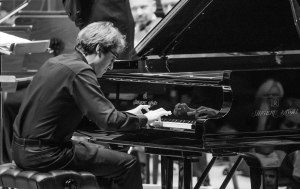
The second Tema con variazioni was more successful as the piano is more exposed. I felt Gadjiev had mastered the angular rhythms and the playing was never less than virtuosic with a powerful dynamic range. The final Allegro again lost that magnificent rhapsodic surge of soloist and orchestra because of the dynamic imbalance – again the orchestra tended to overwhelm the soloist at the piano when in this work the reverse should be true? of course I cannot escape Martha Argerich and Pletnev in this work coursing though my inner ear. Gadjiev is so young and made a magnificent effort – Argerich has been playing it almost all her life.
As an ‘encore’, the next piece was actually programmed, the famous Paderewski Menuet. For me Gadjiev’s performance simply lacked the elegance , charm, stylistic ‘affectation’ and refinement this charming ‘period piece’ demands. Paderewki’s own performance and the scene in which he appears in the film Moonlight Sonata is a delight! Do buy and watch this innocent film.
After the interval the Kilar Symphony No.3 – the ‘September Symphony’. Written as a memorial to the dead in the horrors of 9/11 atrocity and destruction of the World Trade Centre Twin Towers in New York. A strange work full of filmic and thematic reminiscences, bizarre rhythms and ‘textures’ (not melodies ) that we associate with aspects of life in the US. Some of the strangeness verged on the outright comical, other aspects were unsettling, yet others reminded me of Clint Eastwood in a Western riding after the ‘baddies’ across Arizona. Nothing wrong with that. ‘Film music’ is not necessarily pejorative in my mind. Kilar can achieve what might be termed ‘monumental stasis’ in his music, a uniquely still centre and ‘floating’ sound world at the eye of a vortex.
All in all an odd programme to open a Paderewski Competition I thought. I dearly wish more young pianists would learn the Paderewsi Concerto in A Minor – deep, forehead creasing seriousness is not always necessary in musical life. The second movement expresses such innocent lyrical love. A yearning for a lost love…just like a French film of the 1970s. Would be so popular with audiences and at this competition!
* * * *
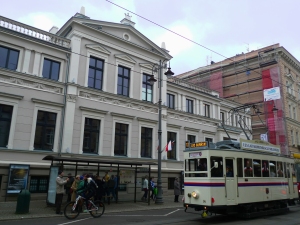

STAGE I – performance duration 25-30 minutes
Free choice of repertoire
In my commentary on Stage I there are so many pianists and works to assess each day you have to forgive my brevity. I attempt to be fair and make constructive commentary. If you are watching the competition online you will be bound to disagree with me! Music is such a deeply personal experience – possibly one of the most profound in life.
Monday November 7th 2016
It was a day of the greatest contrasts one can imagine. This because the competition is one of the few where the participant has a free choice of repertoire in Stage I.
Aleksandra Swigut (Yamaha) Poland It says a great deal about her gentle and reflective character that she chose the 4 Schubert Impromptus Op. 90. They were full of heartfelt yearning and possessed the quality of song. This was not a Schubert haunted by the shadow of death but a man experiencing a yearning of the spirit. At times I even felt Chopin entered the interpretative picture. No:4 was especially moving, where an unusually shortened note at the end of the opening phrase gave the work a new meaning and mood – a sense of fatalistic questioning.
Priscila Navarro (Fazioli) Peru I must confess to not being enamoured of the set of Rachmaninoff Etudes Tableaux (‘studies in musical composition’ or ‘study pictures’) Op. 33. They are varied in texture and piano sonority – almost experimental. I found her performance rather unyielding dynamically although perfectly accomplished technically. These works are difficult to achieve understanding on the part of the listener.
Ilaria Loatelli (Kawai) Italy I felt the Bach Toccata in C Minor to be not is full grasp of baroque style on the piano and could have had more forward drive and energy. The Ravel Oiseau Tristes from Miroirs was possessed of a beautiful, rather dreamy luminous and burnished sound I found quite seductive. The Brahms Variations on a theme of Paganini seemed to be lacking the black coffee, cigars and masculine (if I may be so politically incorrect) gravitas and weightiness of the composer. Repeated phrases were played almost the same and I felt the difference in character of each variation could have been made clearer.
Xiaoyu Liu (Yamaha) Canada The Haydn Sonata in E Minor Hob XVI:34 was familiar to me as I play it myself. I found the sonata stylistically slightly astray although the Adagio was charming. The final movement Molto vivace was splendid although I am sure Haydn would have measured his breathlessness on a square piano! The Ligeti Etude No:4 Fanfares was a work I had never heard – an absolutely astonishing composition! The Liszt Spanish Rhapsody was rhythmically terrifically arresting but taking breath between phrases might have helped. the finish was a flourish of tremendous virtuosity. The audience in the hall loved it and applauded for a long period.
Vasyl Kotys (Steinway) Ukraine His experience, authority and rich tone were obvious from the opening bars of Ravel’s Gaspard de la Nuit – Ondine. The tonal palette for the water sprite was quite ravishing. Le Gibet was haunting with its eloquent pulse of death but actually not threatening enough for me – statistically closer to the great reaper than the pianist! Scarbo was spectacularly evil, meaning with brilliant articulation. Then atmospheric and poetic Liszt/Schubert Gretchen am Spinrade was lovely to hear and rarely performed. His performance of the Liszt Transcendental Etude No:12 Chasse-neige (the depiction in sound of a snowstorm) was a dramatic, exciting and brilliantly impressionistic tour de force. I predict Stage II.
Han Chen (Steinway) Taiwan He began with the incredible Elliot Carter Catenaires (2006) – another modern work I am unfamiliar with. Carter described it: ‘a continuous chain of notes using different spacings, accents, and colorings, to produce a wide variety of expression.’ e were then forcibly transported by time machine in Dr. Who style to eighteenth century Vienna and the Haydn Sonata in D Major Hob. XVI 42. I was reeling from the time-travel but sane enough to realise the Haydn was excellent with only judicious use of the pedal. I was unsure if he had penetrated fully the stylistic climate of Vienna when Haydn was composing. A powerful and fully virtuosic performance of the Liszt Reminiscences of Don Juan. I failed to see in my mind’s ear hell opening to receive the soul of Don Juan, the clouds of sulphur. I feel he should look more deeply into the operatic literature so as to penetrate below the glittering Lisztian surface. It was a fantastic performance but rather unrelenting in dynamic inflation.
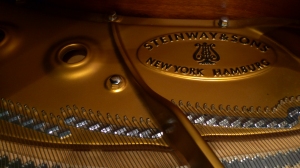
Michael Davidov (Yamaha) Spain/Israel He opened with the Granados Quejas o la Maja y el Ruisenor from Goyescas Book II. It was so lovely to hear this seductive and eloquent music, almost reminiscent of an exclusive club in Madrid in the small hours of the morning. He performed in such an attractive, relaxed style I was captivated. The Scarlatti Sonata in E major , K.20 was performed with perfect understanding of the Scarlatti idiom, slight rubato and Spanish character. Stylish, slightly detache, seamless ornamentation, discreet pedalling – what more can one ask when music speaks like this? I suspect Rachmaninoff Etude-Tableux in E-fat minor Op. 39 N:5 did not entirely suit is temperament. I am afraid I felt he did not penetrate to the core of the Liszt Mephisto Waltz No 1. He should carefully examine the insidious story behind the work, the seductive evil at the base of it. A tumultuous account but lacking in what Liszt was driving at – the irresistible temptations of the sensual in life, those temptations of the body leading the victim where exactly? Not simply a virtuoso display piece….although Liszt conceals vanity in that too!
Tianyu Zhou (Steinway) Canada I loved her spirited and intense account of the Beethoven Sonata No. 7 in D major Op. 10 No: 3. I felt that the profoundly moving Largo e mesto was speaking for the tragic predicament of all humanity – a profound utterance that Beethoven rarely equalled in any composition. This was clearly recognized by Zhou. This fine performance was followed by Liszt Venice e Napoli.
‘Have you ever been to Venice? Have you ever glided on the sleepy waters in a black gondola down the length of the Grand Canal or along the banks of the Giudecca?… Have you seen the moon cast its pale rays on the leaden domes of old St Mark’s?…’ Liszt wrote.
In a public letter to Heine, published as an article in the Gazette Musicale, 8 July 1838 Liszt also wrote: ‘I stood in Venice, on the Bridge of Sighs’ starts the letter, quoting from Byron’s Childe Harold’s Pilgrimage, which Byron completed in Venice. Arriving with Marie d’Agoult in late March 1838, Liszt was clearly captivated by the city, writing engagingly about it in articles which appeared in instalments in L’Artiste. The pianist Christine Stevenson wrote ‘Byron’s shade was also wandering through the lagoons of Venice; Liszt visited Byron’s house, and once travelled in a gondola steered by a man who had ferried Byron about, fifteen years earlier. The gondolier quoted verses by Byron and told Liszt news of Byron’s mistress, Theresa Guiccioli. Liszt, Tasso and Byron – a heady Venetian combination.’ As I have said many times in these posts literature was an enormously important inspiration for Liszt, especially Byron.
Zhou’s performance was tremendously virtuosic but for me failed somewhat paint an impressionistic picture of Venice or Naples. the Tarantella was its usual tour de force.
Yu Mi Hyang (Steinway) South Korea In one of favourite Beethoven sonatas (No: 26 n E-flat major Op. 81a) I felt this participant had not yet mastered the ‘classical style’ at least as I understand it. However the Adagio was eloquent with a deep sense of absence and yearning. In the Liszt Apres une lecture du Dante. Fantasia quasi sonata I felt on more than one occasion she had mastered the structure of this magnificent work, had it well in command but as usual with Liszt, one has to fight beyond the formidable challenges of his required technique through to the literary connotations that inspired him to compose the work.
Eunchan Kim (Steinway) South Korea He clearly has a firm grasp of the classical idiom in the Haydn Sonata in C Major Hob. XVI: 48 although I felt the work slightly over-pedalled but that really is matter of personal taste. In a way I felt the stylistic features rather appliqué than emerging organically from the work itself. A slight lack of Viennese gemütlich essential to capture Papa Haydn’s generally sunny temperament in his piano sonatas, his light-hearted ‘conversational’ musical personality present in his chamber music. The Debussy Feux d’artifice was successful impressionistically but I sought a touch more finesse in his playing. I am afraid to say he betrayed the familiar lack of understanding of the cultural context and ‘story’ behind the Liszt Mephisto No 1, its clear literary programmatic content concentrating as he did on the virtuoso aspects of the work and rarefy moving or taking us beyond that.
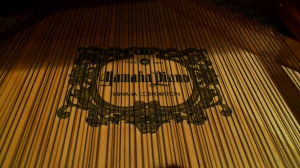
Yedam Kim (Steinway) South Korea Here we have a magnificent musical talent, the finest of the day for me. A monumental account of the Chopin Polonaise-Fantaisie Op.61 where I would wish to make no criticism of this complexly wrought interpretation of one of the most difficult works of the Chopin ‘late style’. The composer was deeply unhappy at this period in his life, exploring the depths of his psyche here as never before. The Ravel La valse was similarly magnificently brought off with all the parts of this fascinating and disturbing work – shifts of mood and texture, rhythmic complexity of the creeping neurosis within the waltz, balance of structural elements all mastered and more than that, quite inspired and supremely authoritative. Wonderful artist. Dare I predict a finalist as this early stage?
Rina Sudo (Yamaha) Japan In the Bach Partita No 1 in B-flat major I am simply full of superlatives. This was ‘superfine Bach’ of fine texture, glowing tone achieved with the most subtle and refined use of the pedal, superb articulation, clear contrapuntal textures (an inspiring independence in the left hand – marvellous delineation of voices) and perfect tempo. I adored it. An unusual choice I felt of the Liszt Hungarian Rhapsody No: 13 which did her fine musicianship no favours as was evident in the Bach. To my mind the Rhapsodies do not tax the deeper elements of musicianship although they do require quite an organic understanding of Magyar dance rhythms to bring off convincingly. I have heard this fine musician many times in competition in Poland and really wish she had chosen Chopin instead of Liszt – she is a wonderful and refined player of this demanding composer.
Michelle Candotti (Steinway) Italy I wondered what could possibly be the character and personality of a young pianist who had the temerity to choose the Liszt B Minor Sonata as a Stage I competition piece. Was it arrogance or a deep love of one of the greatest works in Western piano literature she had to choose it? Then she appeared on the stage – a lovely young Italian girl (may I) in a modest burgundy velvet dress and headband. I thought to myself ‘And she is going to attempt the Liszt Sonata?’ It just shows how wrong one can be! From the duration and ‘attack’ of the opening notes (always the indicator of how the work has been conceive by the artist) I became increasingly astonished as it proceeded, then seriously began to consider her account as a precocious talent. Not just by the technical mastery (amazing enough in one so young) but in her clearly deep understanding of the profound nature of this work and what it was ‘about’. No, it was not an ‘immortal’ performance but what an astonishing and fine musical gift we have here! The courage of this choice amazed me and I am full of respect for the confidence it betrayed. She allowed the music to breathe and has clearly studied the cultural and literary context of the work and Liszt’s deeper metaphysical intentions here (unlike too much of the Liszt we have heard so far). The interpretation moved me greatly – Bravo! She will definitely move on through the competition…
Tuesday November 8th 2016
Nora Bartosik (Steinway) USA The Haydn Sonata in B Minor Hob XVI 32 was excellently played but I felt stylistically rather vague. The gemütlich Viennese element so important Haydn piano sonatas and his chamber music escaped this pianist. Despite this a superfine final movement Presto. The Debussy Poissons d’or was possessed of radiant colours and clearly a strong composer in her repertoire. She began the Bach/Busoni Chaconne in D Minor rather gently and then delivered a rather winning ‘Romantic Bach’ on the piano with beautiful tone. I am not fond of Busoni arrangements of Bach (being a harpsichordist) and found the unrelenting heavy dynamics most unsettling. Busoni does allow Bach to speak alone occasionally – moments of beauty. The Busoni arrangements of Bach chorales are often very moving and his most successful arrangements to my mind. Anyway the la terra trema was in evidence here as Busoni no doubt intended.
Tainaka Takuya (Steinway) Japan I felt in the Bach Prelude, Fugue and Allegro in E-flat major he had formed a rather prosaic view of Bach – rather monochromatic and far too regular – the Allegro had a touch of the sewing machine. The pianist has the talent to easily make far more of this work. In the three works he chose from the Debussy Images Book II he produced very fine tone colour which bordered on losing focus entirely as impressionism began to increasingly suffuse the picture. The Liszt arrangement of the Wagner Liebestod from Tristan und Isolde – arguably the greatest love song ever written – began so violently I doubted the pianist knew what this siren song was ‘about’. The passion has to rise within the interpreter organically and subtly. As we have seen with Liszt time and again already in this competition, one must go beyond the technique of dealing with the notes however fearsome they may appear.
Aleksandar Pavlovič (Steinway) Serbia He began with the Mozart Fantasia in C minor K.475. The mercurial changes within the work are difficult to master and I felt in an otherwise good performance, he had not yet mastered the ‘classical style’ sufficiently. The Schumann Toccata Op.7 was unfortunate and needs a great deal more work. Phrasing and taking breath in the right places is vital to its success. It needed a lot more chiaroscuro in the colour palette and the tone verged on the harsh at times. The winner of the previous competition in 2013, Zheeyoung Moon, gave a fabulous performance of this Toccata which anyone who loves this piece should listen to – surely one of the finest since Richter
Aleksandar was far more successful in the Shostakovich Prelude and Fugue in D-flat major Op.87 No: 15. I thought he mastered the strange waltz in the Prelude and the savagery of the vivace fugue, itself a tour de force of chromatic and atonal writing. The subject contains 11 of the 12 semitones available.
Svetlana Andreeva (Steinway) Russia A fascinating programme! Here to my mind we have a distinct and unique musical phenomenon and charismatic personality. Here we have a player whose human fabric is utterly possessed by the nature of the sound she is producing, entering spiritually and physically into it – well at least on this occasion. A very special musician indeed of a most particular sensibility. The Ligeti Musica Ricercata VIII Vivace. Energetico IX. Bela Bartok in Memoriam X. Vivace. Capriccioso was truly memorable. It literally exploded over us with a power and conviction that was awesome – to use an overused word. Her arresting appearance with enormously long blonde hair severely tied back into an endless ponytail that almost reached the floor only added to the strangeness and unique power of the experience. The Beethoven Variations in F major Op. 34 were tremendously expressive, verging dangerously on a harsh tone for Beethoven. The interpretation had great nobility and authority, placing Beethoven on the cusp of the ‘Classical’ and the ‘Romantic’. The Scriabin Sonata No 9 Op. 68 (known as the ‘Black Mass’ Sonata written 1912-13) suited her labile temperament to perfection. The work is incredibly demanding both physically and psychologically for the pianist. Chromatic, atonal and dissonant it lasts about 10 minutes and is one movement. The work defies analysis but Svetlana invested it with a menacing metaphysical and lugubrious texture. The intense harmonies resolve their tensions in desolation and despair in a concluding low F natural. An extraordinary musical moment of great intensity.
Adam Tomaszewski (Steinway) Poland The Clementi Sonata in B Minor Op.40 no 2 tended to be rather rushed with blurred phrases. If only he would take his time and breathe… I also felt it lacked he required classical style for Clementi. The Chopin Berceuse was a very fine performance – innocent, warm and gentle in its infantile sentiment, the rocking rhythm of the lullaby a well controlled rubato and constant left hand as Chopin advised. The magnificent Debussy L’isle joyeuse was an accomplished performance but lacked sufficient impressionist atmosphere – I yearned for more of ‘French’ sensual character. He will continue to develop as a pianist if the lovely Berceuse is anything to judge by.
Alexander Panfilov (Fazioli) Russia The Beethoven Fantasia in G Minor was rather unfamiliar to me I must say and I did wonder why the pianist chose it. However that Russian piano sound hewn out of solid gold was evident seconds after he touched the magnificent Fazioli. A pianist of immense keyboard authority, powerful tone and refined touch. The Chopin Ballade No 2 in F major op.38 was a fine performance betraying complete understanding of structure and the absolute musical narrative contained within these pieces. My ‘personal Chopin’ (we all have one you know) would have called for slightly more poetry. The Rachmaninoff Etudes-Tableux (Op.39 No 5 in E-flat minor and No 6 in A Minor) were absolutely magnificent and monumental in scale. Dynamically and rhythmically arresting and containing frightening emotional extremes, the works interpreted by Panfilov indicate he is a born Rachmaninoff player. As I have said, I am not fond of these works played poorly (as they generally are) but presented in this overwhelming manner I experienced that tell-tale tingle going up and down my spine – the incontrovertible sign of being in the presence of great art. The Fazioli instrument with its rich bass of velvet softness and resilience elevated the Rachmaninoff to the heavens of passion. The registeral balance of the instrument is very fine. All this transcendental musical business was carried out in seemingly effortless fashion breaking no sweat.
Misora Osaki (Kawai) Japan The Haydn Sonata in C Major Hob. XVI 50 was joyful and animated like a glass of the finest Dom Perignon champagne. The clarity of sound and polish of execution was appropriate and an absolute delight. It sparkled with good humour – perfection in its way. The Liszt Feux Follets was just as mercurial as any Will o’the Wisp one might encounter with a glittering sound, perhaps slightly heavy on a rare occasion – all Jack o’Lanterns are not the same intensity after all as they seduce the wayfarer along unfortunate wrong paths. I was rather unfamiliar with the Szymanowski Variations in B-flat Minor Op.3 but the whimsical shifting moods of great contrast were marvellously captured – one variation towards the conclusion is music of such civilised and fin de siècle charm, encapsulating the finest in human creativity. How we need this today…
Narmin Najafli (Yamaha) Azerbaijan I was fascinated to hear a pianist from such an exotic location (well, for me as an Australian). In the Bach Prelude and Fugue in E Minor she showed admirable control over the contrapuntal texture and voices with excellent tone and judicious use of the pedal. The Chopin Andante Spianato warm and beautifully wrought and the Grande Polonaise had nobility and showed an instinctive understanding of the complex nature of this composer. The ‘call to the floor’ for the Polonaise was well brought off as an imperative summons. Perhaps it did not glitter as it can with greater virtuosi but in this performance I felt that to be irrelevant. The nature of the Debussy Etude No 5 on the other hand seemed to elude her and was not outstanding. I so admired her courage playing Chopin in Poland – she was so nervous but pushed through that terrible barrier to give us a fine recital. Bravo!
Yuka Morishige (Steinway) Japan I felt the classical style of the Haydn Sonata in C Major Hob XVI 50 was not managed as well as it might have been and it did not have that internal gemütlich Viennese element. The Scriabin Sonata No 9 although extremely well played for me lacked the metaphysical element and unsettling and profound senses of existential loneliness so vital to this composer in bringing off this dark and lugubrious piece. In the Debussy L’isle joyeuse she was far more successful and gave a fine rendition of this magnificent piece. The triumphal ending revealed a player of tremendous power and range of expression – by far the most superior part of her programme.
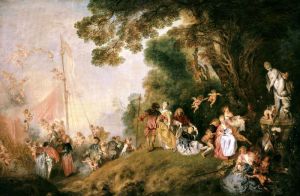
Ilya Shmukler (Kawai) Russia This was truly a supreme recital on every level of musicianship. His superb incandescent tone was evident from the outset – the first few seconds of the Bach-Siloti Prelude n B minor began to carry me away and wonder how he achieved this sound. The eloquent melody rose like a human voice of great beauty. The Ravel Gaspard de la nuit was similarly glorious in its keyboard mastery and the tone and touch achieved, the sheer range of colours that emerged from the instrument. Ondine was highly impressionistic with a sound palette ‘to die for’ as celebrities gush in Hollywood, so evocative of this fugitive water sprite. Le Gibet was marginally less convincing and I felt it could have been more ominous and haunting played as it was at quite a low dynamic, scarcely rising above mezzoforte. Yet the sound hovered over us more as a premonition of death than the presence of the Great Reaper himself. As if he was behind glass waiting….I must consult the score as I cannot remember the detailed dynamic indications. Scarbo was simply fantastic and scarcely credible in its virtuoso command. But much more than this. His fantastic articulation unleashed the terror of this evil creature….at a crushing in irresistible tempo. The variety of touch, tone and articulation was breathtaking. The grotesquerie and mercurial nature of the piano writing here was pregnant with hidden threats, danger and authentic nastiness. A recital and account of this work to treasure in the memory. Rare for a Russian artist to choose Kawai but then this is a premier hand-built Shigeru Kawai that suited this music to perfection…
Andrey Denisenko (Steinway) Russia What can I say? I am full of admiration for this pianist who decided to present this powerful, angular and incredibly demanding Shostakovich Sonata No 2 in B minor Op. 61 in Stage I of this competition. The work was composed in 1943 after Shostakovich had been evacuated to Samara after the Siege of Leningrad. I found the Largo mesmerising in its loneliness and isolation, an extraordinary contrast to the movements that bracket it. Emil Gilels championed this sonata but I am truly not sufficiently equipped to judge this performance having heard it perhaps once long ago. I am astonished that Shostakovich’s exciting and disturbing piano music is not more often performed – market forces in today’s commercial concert halls where the golden calf rules repertoire?
Tatiana Kachko (Yamaha) Russia In the attractive Bach-Fineberg Aria variata alla maniera Italiana BMV 989 she possessed excellent rhythm, fine tone and touch and judicious use of the pedal. On occasion I found it somewhat unrelenting in drive and dynamics. The Debussy Etudes No 5 Pour les octaves and No 11 Pour les arpeges composes beautifully played with total command but perhaps not as outstanding as she might wish in this elevated company of strong Russian pianists. A rather unfair comment but this audience is spoilt by the high pianistic quality of this competition. What listeners not in the hall are missing! She completed her programme with the Verdi-Liszt Paraphrase de concert sur Ernani. I cannot warm to this work but she gave a fine virtuoso account of it that certainly showed an understanding of the opera based on the Victor Hugo play Hernani. It was an immensely popular opera hence the Liszt paraphrase of it. Thousands of music lovers thanked Liszt for this work. Remember it was the only method of reproduction in the nineteenth century without seeing it live.
Mo Zhou (Yamaha) China From the moment he walked onto the stage I knew we would have an individualistic approach to his chosen programme. Excellent hair à la mode! The Scriabin Poeme Op. 32 No 1 was presented with the most seductive sonority imaginable. A fine and poetic interpretation with a velvet touch and tone acquired by clearly a highly self-critical ear. The Beethoven Sonata No 28 in A Major Op. 101 showed a complete youthful creative rethinking of the work – certainly compared to the standard approach that inhabits my traditional inner ear – Brendel, Schnabel, Backhaus…I would love to examine in detail what he achieved here but reviews of this type are unavoidably brief.
The first movement moved Beethoven over the cusp beyond the classical canon to the meditative and introspective Romantic. The contrast with the rumbustious Viva alla Marcia was thus all the greater with very creative pedalling. The Adagio is marked by Beethoven ma non troppo. At times I felt the pace slowed almost to stasis and needed the impetus of more forward momentum, yet the improvisatory even meditative quality was deeply moving. Such a wild contrast with the following Allegro! I felt it verged on dynamic and tempo over-inflation and was just a little disturbed by this clear movement away from the classical canon clearly for dramatic impact – but then this is a late sonata. At all events a creative young player of commanding technique who rethinks the standard repertoire and responds to it creatively – rare enough!
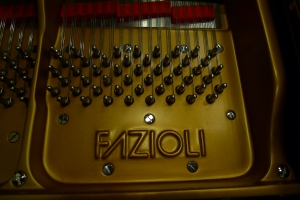
Wednesday November 9th 2016
Yun-Ho Chen (Steinway) Taiwan The Bach Prelude and Fugue in D Major WTC II. The Prelude was executed with great elan but rather to up tempo for my taste. The listener wants to be able to follow the wonderful harmonic developments and needs more time than the pianist who is intimately engaged with the work. The Fugue was finely presented with all the voices clearly delineated in their counterpoint but the dynamic remained level throughout. It is well to remember that Bach wrote these works for the clavichord which was capable within a small range of dynamic alterations and the wonderful bebung which permitted a type of vibrato as the finger was in close contact with the string through the brass tangent at the end of the key. The piano is clearly a development of the clavichord not the harpsichord. In the Ravel Gaspard, Ondine was impressionistic and beautifully wrought. In Le Gibet the isolated spectre of death was present but I felt that that lonely isolation contained in this extraordinary movement was not quite achieved. In Scarbo despite the mastery of the keyboard an atmosphere of threat and horror of this vile creature was not sufficiently omnipresent. One has to become Scarbo if one is a pianist. Moments of great beauty however.
Yasuko Furumi (Steinway) Japan played my favourite Chopin polonaise, the F-sharp minor Op.44. ‘Correctly’ played but no more than that – an absence of deeper penetration of the score. She had a lovely cantabile tone in the refective central section and a noble and angry conclusion – quite right too. The Chopin in E major Op. 62 No 2 was all one could ask for in terms of romantic lyricism. So why on earth she followed this with the Shchedrin Basso Ostinato with its unapologetic fierceness I cannot know. When the Shchedrin burst upon us without warning, I almost flew out of the window in fright! A small Japanese girl playing this mighty work as a sight to behold – astounding. To finish she performed the Verdi-Liszt Danza sacra e duetto finale d’Aida. I did not know this rather lovely understated Liszt paraphrase (?) with its celestial conclusion – a lovely work.
Tomoka Shigeno (Yamaha) Japan She opened her recital with the Bach Partita No 1 in B-flat major. I loved this interpretation, so full of internal life. True to baroque performance practice she greatly varied the articulation (yes, it can be done on the harpsichord) and also to my delight the ornamentation. The piece came triumphantly to life with the clearest counterpoint. The Sarabande was engaging emotionally and ardent in mood. I noticed her singing to herself on occasion (a la Mr. Glen Gould). The Franck Prelude, Chorale and Fugue revealed her a serious and commanding player, quite unlike the fine-boned Japanese lady pianists we sometimes associate with the piano. The conclusion was triumphal.
Tomasz Zając (Steinway) Poland The Bach English Suite No 3 is my favourite among the suites and I was looking forward to what he would make of it. Excellent articulation and judicious use of the pedal. With minimal ornamentation there was not a great deal to hold the interest of the listener over a longer period. A fine performance of course but he could have made far more of this suite. Don’t hold back Tomek! He concluded with the Liszt Funerailles which was a careful ‘correct’ interpretation rather than an abandoned and passionate one (which I think this tortured work deserves).
Stefan Bonev (Steinway) Bulgaria The variation form obsessed Beethoven as is clear in the 32 Variations in C minor WoO 80. Bonev showed great variety in his approach to each variation and a full grasp of the classical style. He clearly had a passionate engagement with this work. The Ravel Jeux d’eau was beautifully accomplished – tone, touch, colours of the spectrum… I particularly like the Prokofiev Sarcasms Op. 17 which he played with masculine strength (if I may so bold) and full emotional commitment. Sarcasms is not merely a collection of sonic shocks and musical pranks strung together in a group of truly “sarcastic” pieces. Indeed, Prokofiev shows his richly lyrical side in these pieces, especially in the first (Tempestuoso) and third (Allegro precipitato). The fifth, Precipitissimo, is a depiction of laughter – not the laughter of sarcasm, but that in the face of tears (Robert Cummings).
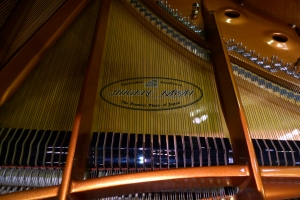
Tymoteusz Bies (Steinway) Poland Ferrucio Busoni wrote a huge number of Bach arrangements but the only ones I can really tolerate are those of the Bach Choral Preludes. This one was of Num komm’ der Heiden Heiland and it was eloquently played Tymoteusz. He then embarked on what was to become a marvellous performance of the Rachmaninoff Sonata No 2 in B-flat Minor. It had a strong and powerfully realised by Bies beginning with just a hint of too much pedal. His finger technique and dexterity are not quite as spectacular as a number in this competition but that seems to me to be an irrelevance in this context. There was a strong feeling of improvisation, even meditation in some beautiful passages in the second movement, searching for direction. Despite a few shortcomings it is obvious this pianist has studied the cultural context surrounding this formidable work and knew what it was ‘about’.
Anastasia Nesterova (Steinway) Russia This programme was one of the high points of the competition so far and I would be surprised if she was not a finalist. The Chopin Scherzo No: 4 in E major op. 54 was a superb interpretation on every level and very moving particularly in the reflective cantabile central section. Her radiant tone and seductive touch are quite divine. A deeply understood account of Chopin’s intentions in the Scherzo, so far from a ‘joke’ which is the literal translation from the Italian. The Chopin Nocturne in C Minor p. 48 No 1 was taken at a considered tempo which allowed the poetry to breathe and take hold of the listener. A wonderful Chopin player with superb technique and keyboard mastery. There were wonderful moments of nervous agitation in the conclusion…close to tears I am not ashamed to admit. Then a magnificent Liszt Mephisto Waltz No:1. (Der Tanz in Der Dorfschenke – The Dance in the Village Inn) with unquestionable technical command. Unlike too many in this competition who performed it she clearly understands the sensuality of the work and seductive evil captured within it. Liszt was obsessed by Faust and he chose the account of the story by Nikolaus Lenau to set this piece of programme music. This passage from Lenau appears in the actual score:
“There is a wedding feast in progress in the village inn, with music, dancing, and drunken carousing. Mephistopheles and Faust wander by, and Mephistopheles persuades Faust to enter and join in the festivities. Mephistopheles grabs the violin from the hands of a sleepy violinist and draws from the instrument seductive and erotically intoxicating strains. The amorous Faust whirls about with a sensual village beauty [the landlord’s daughter] in a wild dance; they waltz in mad abandon out of the room, into the open, away into the woods. The sounds of the violin grow softer and softer, and the nightingale sings his love-soaked song.”
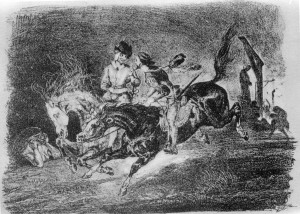 |
| A Lithograph from Delacroix’s Faust |
Sejoon Park (Steinway) USA He began his programme with yet another Bach arrangement, this one familiar to everyone, the Egon Petri Sheep may safely graze BMV 208. I found this an odd competition choice (however beautiful a piece) as one surely wishes to display something unique in one’s artistry. He followed this with the set of Rachmaninoff Etudes-Tableux Op. 33 which revealed a powerful and commanding player, tending on occasion to overwhelm us with sound. Lyrical and reflective too with a rich cantabile but there was an intensity of approach overall which I found discomforting – unavoidable personal taste once again to the fore.
Tatiana Dorokhova (Steinway) Russia I would not wish the responsibility of the jury on anyone as this competition is unfolding. It is a particularly strong field of massively accomplished competitors, the Russian contingent in particular. Far stronger than 2013. The discipline, work and inspired training in Moscow that produces such remarkable figures leaves me gasping…
Dorokhova began surprisingly with the so-called ‘Les Adieux’ Sonata of Beethoven – No 26 in E-flat major Op. 81a (not the programmed sonata we all expected) which was satisfying on every level, especially the eloquent Abwesenheit (Absence) which was highly emotional with moving rubato. She tended to rush the joyful Das Wiedersehen (Return) which detracted slightly from the emotional high. Arrau is wonderful and deeply penetrating in this sonata which expresses so much of the deep emotional and human need for company and human warmth cruelly denied the great composer. Dorokhova then launched into my favourite ‘warhorse’, the Balakirev Islamey Op. 18. A rather more expressive reading than usual but what can one possibly say of the astounding technique she displayed as the work developed. She had the courage to take enormous risks at the very limits of her formidable abilities which resulted in tiny slips which just added to the excitement of this interpretation. An absolutely breathtaking account to compare with the piano rolls made by the great Josef Lhévinne – and that is saying something! In Formula I racing car parlance – driving at 10/10ths – heart-stoppingly exciting.
Dina Ivanova (Yamaha) Russia Human nature in all its wonderful variety – what a miracle life is! Three female Russian pianists each possessing formidable abilities but each of utterly different characters and temperaments. This poetic and artistic creature chose to open her excellent programme with three quite outstanding and spiritually uplifting and life-enhancing Scarlatti Sonatas (and how we need a measure of spiritual confidence injected into us just now, world events as they are unfolding). As a harpsichordist but here on the piano, I can say the G Minor K.476 had a fabulous detaché character full of glitter, enlivening energy and refinement. The D minor K.1 was full of charm, elegance and sheer delight in a life filled with celebratory joy. The D minor K.9 was judiciously under-pedalled with just a hint of the Bartolomeo Christofori early piano Scarlatti would have known at the court of Queen Maria Barbara at the Escorial.
Then two Chopin Nocturnes Op.27 – No 1 in C-sharp minor and No 2 in D-flat major. These were so full of heartfelt yearning and unsentimental beauty, tone colour and feather light expressive touch I am unashamed to say I was again deeply moved to the emotional depths. The incandescent tone she produced floated above us by some miracle and hovered there like a halo…a rubato that can only emerge from deep love of the music. Her arms move in arabesques like reeds in the breeze…
Liszt had a lifelong devotion to Schubert which gave rise to arrangements of over fifty of his songs transcribed for piano. He was very faithful to the Schubert score. In 1837 while staying as a house guest at Nohant with George Sand, her friends and her lover of the moment Michel de Bourges, Liszt would play in the warm summer evenings after dinner. ‘With the old house bathed in moonlight, and the pine trees swaying gently in the perfumed air, the music began to drift over the grounds. He played mostly Beethoven and Schubert.’ (Alan Walker Franz Liszt Volume I p. 244). His neurasthenic mistress Marie d’Agoult had recently translated some Schubert song texts into French for the composer. He often continued playing quietly in a dream reverie long after the rest of the company had gone to bed and Sand was writing in her room.
We were treated to two Liszt arrangements of Schubert – Auf dem Wasser zu singen a type of sung Barcarolle (‘To be Sung on the Water’) full of plangent harmonies, which built to a climax of something resembling ecstasy and then the terrifying and technically demanding Erlkönig. The famous and ominous repeated octaves of the opening of the setting of Goëthe’s poem…the frenzied galloping of the horse ridden by the father clutching his dying child, pounding though the dark wood haunted by the King of the Alder Trees was marvellously captured.
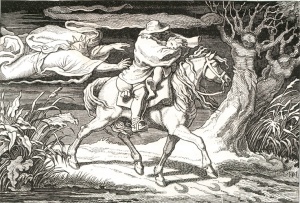
The accompaniment piano part in Schubert songs is often very difficult in itself but Liszt weaves the sung melodic lines through his transcriptions with great and ground-breaking intelligence and skill. He played it in many European capitals and it became a great favourite as well as spreading the name of Schubert which was hardly known outside the Vienna of the day. A fine performance, never exaggerated or hysterical, simply haunting and full of dark menace. Competition high point surely.
Andrzej Wierciński (Steinway) Poland His three Scarlatti sonatas (excellent choice) were excellent and idiomatically realised. This was followed by a fine, grand and noble performance of Bach-Busoni Chaconne in D Minor BMV 1004. He brought out the great organ texture and magnificence of the work with both art and power. Then a work I had never heard, the Tchaikovsky-Pletnev Andante maestoso from the Nutcacker Suite. The familiar tune undergoes a massive transformation yet why he chose this work as a competition piece…well, it is a free choice of programme and I trust he must quite understandably love the work. I notice there have been a remarkable and surprising number of Liszt paraphrases and transcriptions so far in the competition.
Kosuke Akimoto (Kawai) Japan A fascinating programme clearly given a great deal of highly intelligent planning. The Beethoven Sonata No 22 in F major op. 54 opened his recital. A firm grasp of the classical style but with scarcely any pedal at all which resulted in a rather austere Beethoven to my mind, a man somewhat drained of emotion. The tempo was rather too fast for my ear to follow and give me time to rise to the appropriate emotions but otherwise excellent. Then a piece by a composer who is becoming a favourite of mine by virtue of the competition introduction to his work – the piano music of Ligeti. In this case the wonderfully and evocatively entitled L’escalier du diable – Etude no. 13. The fantastic angularity and abstract nature of this work, its power and disjointed resonances are tremendously stimulating to the imagination as we climb this sinful staircase. Like Scarlatti the visual element of extreme ‘geographical’ dislocation of hands, arms and torso of the pianist make for added theatrical drama. Hypnotic and addictive music. In a moment of great musical inspiration, Akimoto allowed the resonance of the Ligeti to fade in the instrument for perhaps thirty seconds or more, carefully releasing notes to slightly alter the harmony until the sound almost disappeared which then merged seamlessly into a pianissimo opening to the Ravel Le Gibet – equally and more seriously and atmospherically evil. A brilliant and genuinely avant-garde idea. His repeated intoning of what one might call ‘the bell of death’ in the left hand was profoundly moving. Haunting and frightening at once. Then a complete change of mood – a burst of optimism in life – the P. Pabst Concert paraphrase on Sleeping Beauty – something I had never ever heard before. The absolutely huge introduction to this incredible and outlandish confection I found highly entertaining! Brilliant programming Kosuke! Bravo!
Hyuk Lee (Steinway) South Korea Here we have a prodigious talent in a young boy of 16. He began with the Mozart Sonata in D major K.311. In the opening Allegro, immaculately executed in the ravishing sound produced by South Korean pianists (yes, I believe it to be unique – think of Seong-Jin Cho) I could only think of Mozart himself as a young man. The Andante was an example of innocent perfection and balanced taste. I did feel he could have made far more of the Rondo which sparkled in an emotional vacuum. The Stravinsky – Agosti Firebird Suite was spectacular and theatrical at once with astonishing penetrative yet crystalline tone. Accuracy and attack were quite astounding in this demanding work. The Lullaby was very atmospheric – every note perfectly weighted. And could I hear the Orthodox declamation of bells of Kiev or St. Petersburg in the Finale? I think I did…To end this astonishing performance from a boy of 16, a glittering La Campanella that any pianist would sacrifice much to play – even a Faustian pact with the devil? We have had much of old Faust and his spiritual travails in this competition so far!
Thursday November 10th 2016
Jenna Sung (Kawai) GB Padre Soler instead of Scarlatti – his Sonata in D Minor R.120. Excellent performance – no pedal to speak of – detaché -rhythmically sprightly. This was a pleasant addition to her programme but other than relaxing her into the competition proper I thought it a rather inconsequential addition. The Ravel Gaspard was well suited to the Shigeru-Kawai instrument. Ondine possessed a truly sparkling impressionist painting in sound of water enveloping the whimsical sprite. This pianist invests the work with intense emotion and extreme subtlety, listening all the while to the sound she is producing. In Le Gibet I felt a particularly deep involvement with the music and the creation of wonderful colour palette and nuances. She really is a highly artistic and poetic performer. Scarbo betrayed tremendous imagination. I felt she was seeing the antics of this vile creature in her mind’s eye – the furtive comings and goings, the vicious sallies – ‘the creature’ truly came to life. Mercurial with fantastic shifting moods this Scarbo was driven by inner complexes and horror and murderous drives. Sung revealed many internal details rarely revealed by other pianists. Wonderful control of mood through sound and colour – a painter indeed. For me the most deeply satisfying Gaspard in Stage I and we have heard a few!
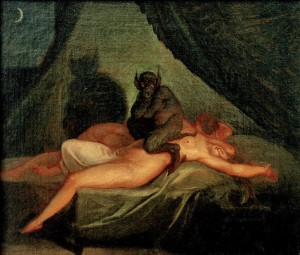
A small literature lesson for you all:
‘Gaspard’ is the Persian guardian of the treasures and so ‘The Treasurer of the Night’ creates allusions to someone controlling everything that is jewel-like, dark, mysterious. The work was inspired by poems of Aloysius Bertrand, the French Romantic prose poet.
Listen! – Listen! – It is I, it is Ondine who brushes drops of water on the resonant panes of your windows lit by the gloomy rays of the moon;
Le Gibet
What do I see stirring around that gibbet?
Faust.
Ah! that which I hear, was it the north wind that screeches in the night, or the hanged one who utters a sigh on the fork of the gibbet?
Scarbo, a goblin that is terrifying a sleeper in his bed.
Oh! how often have I heard and seen him, Scarbo, when at midnight the moon glitters in the sky like a silver shield on an azure banner strewn with golden bees.
How often have I heard his laughter buzz in the shadow of my alcove, and his fingernail grate on the silk of the curtains of my bed!
After this I did not really need to hear the contrast of a Liszt Hungarian Rhapsody, even a rarely performed one. I felt in many ways she was far too good a pianist for this piece. I think the Rhapsodies benefit by being played somewhat ‘roughly’ as in an inn somewhere in Transylvania. Okay sacrilege…many are excellent music. For me this though, performance was rather like a great operatic soprano such as Kathleen Battle singing a popular song from a good musical – too comme il faut and rarely succeeds. A real pity.
Teak Gi Lee (Steinway) South Korea He began fairly conventionally with the Bach Prelude and fugue in B-flat minor which was a straightforward interpretation. In the Schubert Impromptu he expressed an extensive and beautiful range of emotions, his careful legato phrasing correctly and inspiringly associating the work with Schubert’ sublime songs. The Liszt Apres une lecture du Dante: Fantasia quasi sonata had a dramatic opening followed by incredibly fierce and intense playing. There were also beautiful reflective and poetic passages with a great deal of colour and nuance delivered with fine tone. Occasionally I felt he broke through the tone ceiling of the instrument with this impassioned account. He was totally committed to the work with spectacular involvement.
Yuri Noh (Steinway) South Korea After the Dante sonata we heard just before, the Haydn sounded like a tinkling music box! The D major Sonata Hob: XVI: 24 is not one of Haydn’s most interesting sonatas. I found it rather perfunctory as I felt she could have made far more of it expressively than she did. It calls for a sense of delight and evident good humour. The Boulez 12 Notations however was a fascinating and interesting choice. I think her memory for such an abstract piece is quite phenomenal. The work has extreme varieties of timbre, articulation, dynamic range, colour – in fact it tests everything associated with piano playing. And the contrast with her final work the Alfred Grünfeld arrangement of selections from Die Fledermaus – what a time-travel shock to be catapulted backwards 100 years! She generated a late nineteenth century virtuoso sound for this piece. For me it was not quite ‘Viennese’ enough in rhythm and also lacked charm and gemütlich. Virtuosity must always remain the servant of poetic charm.
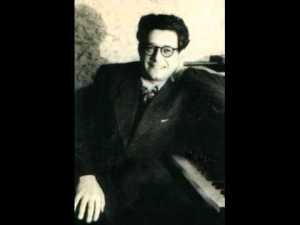
Alfred Grünfeld

Jakub Kuszlik (Steinway) Poland The Clementi Sonata in D minor Op. 40 was an interesting choice from his undeservedly neglected sonatas. Both Beethoven and Chopin regarded them highly and recommended and taught them to their pupils, Beethoven to his nephew Karl. I can think of possibly more impressive ones however such as the great G Minor Op.34 No 2 which Horowitz loved. There were ‘flashes’ of classical style but not a great deal of artifice, Clementi occupying the cusp between the 18th and 19th centuries after all. The Adagio con molto espressione had beautiful cantabile and poetry which led seamlessly into the final Allegro. This is a buoyant and joyful movement with some humour. I felt however for pieces of this nature his touch and tone could be far more refined for such period works.
The Prokofiev Sonata No: 3 in A minor suits his technique and temperament admirably as a percussive player. The piece moves through many different mood as the titles of ‘movements’ indicate
Allegro tempestoso – Moderato – Allegro tempestoso – Moderato – Più lento – Più animato – Allegro I – Poco più mosso
Elżbieta Bilicka (Yamaha) Poland Delightful energetic playing full of joy in the Bach French Suite No 5 in G major BMV 816. Reflective too – never forget Bach after all was a highly emotional man. Beautiful tone, refined touch, minimal pedal and varied articulation. Just right for Bach and this opinion from a harpsichordist. I am very fond of the Haydn Variations in F Minor Hob XVII:6. Very stylishly executed and perfectly ‘classical’ in idiomatic style. This pianist is an intensely musical being – a highly refined musical temperament. This judgment was confirmed in a fine Chopin Scherzo No 4 played slightly detaché which gave it a definite scherzo fizzing energy and character. A most eloquent and evocative unsentimental cantabile in the central bel canto section – both rhapsodic and ardent at once. Not simply piano playing but music!
Xiaohui Yang (Steinway) China This was not entirely the style of playing Mozart that I warm to as I prefer the tempo of his Allegros to be more restrained in tempo, then as a listener I can follow more easily where the music is heading. I want to feel the Viennese affectations and gemütlich. The Adagio on the other hand was warm and affectionate – deeply felt and emotional. As you might imagine I found the tempo of Presto rather too ‘presto’ for me. It would be interesting to know what this tempo indication meant in 18th century Vienna. Perhaps with the light actioned Graf or Walter instruments it would actually have been played like this. A wonderful sonata. The English pianist Christian Blackshaw recently gave a highly successful cycle of the Mozart sonatas at the Wigmore Hall in London – very considered tempi and much to my taste. All so personal isn’t it…this music business…
The Bartok Improvisations on Hungarian Peasant Songs Op. 20 was brought off very successfully with a firm grasp of those difficult rhythms. Anyone who is familiar with my other reviews will know I do not like the Chopin Barcarole to begin with a harsh thump of the gondola against the wharf at the outset of a romantic excursion across the Venetian lagoon. The function of the opening ocatave is simply to gently set the restrained impressionistic tone of the work. It is a love song after all with some agitated emotions developing as the gondola excursion proceeds – as happens between, shall we say, civilised ‘Chopinesque lovers’. I found this (as is often the case) a scene of far too much ‘storm and stress’. This is work of rather delicate fluctuating romantic moods, not simply a pianistic exercise. If you look at the score the indicated dynamics rarely rise above forte and remember it is a Chopin forte which is at least one degree lower than our own view of it on a huge Steinway. For education in sound, play the Barcarole on a Pleyel instrument of Chopin’s period and then transfer what you learn about the nature of his colour, pedal and sound (and you will learn a great deal) to the Steinway.
Anatoli Kostiuchenko (Yamaha) Ukraine Two fine Scarlatti sonatas opened his programme even if slightly over-pedalled for me – but then that way of playing Scarlatti on the piano has been established for a long time. The Chopin Mazurkas Op.6 I found perfectly idiomatic and delightful. There was no pretention here which often happens when their ‘Polish’ rural character is heavily emphasised. The Balakirev Islamey was overwhelmingly magnificent – an absolutely breathtaking virtuosic performance with an ardent, singing lyricism when required – a rare occasion mind you in this astonishing piece of music that never ceases to astound!
Yuanfan Yang (Steinway) GB The Schubert Impromptu in B-flat major Op. 142 No. 3 D.935 was beautifully prepared and immaculately executed with just the right degree of emotional restraint, both elegant and nostalgic eschewing overt display. I would love to hear more Schubert from this refined artist. Then a piece I was unfamiliar with – Landscape by the contemporary British composer Philip Cashian (b. 1963) who is head of composition at the Royal Academy in London. A highly original and meditative exploration of the nature of sound to seduce the consciousness – the dream on occasion suddenly and even violently disturbed as happens too often in life. I would like to hear more of this composer and will search him out. Yang concluded his programme with a magnificently transparent Prokofiev Sonata No 7 in B-flat major op. 83. He brought a ringing clarity with his crystalline sound which revealed all manner of detail in the score usually drowned in pedal, over enthusiasm or insufficient technique. In this powerful and percussive work he never broke through the sound ceiling of the instrument which happens all too often in performance. The Andante caloroso was possessed of a seductive and calm cantabile that was deeply moving. The despair and anger that suffuse this second of Prokofiev’s “War Sonatas” was well captured and penetratingly expressed. The clarity of sound this pianist produces added greatly to the powerful impact of an exciting and fiercely protesting anger in the Precipitato movement as he built the drama to a devastating climacteric. A brilliant reading.
Participants accepted to Stage II (in order of appearance)
If you have read my reviews you will know I am suffering and somewhat bemused by some Jury decisions…it is always the case.
4 Liu Xiaoyu
6 Chen Han
11 Kim Yedam
12 Sudo Rina
13 Candotti Michelle
17 Andreeva Svetlana
19 Panfilov Alexander
20 Ozaki Misora
23 Shmukler Ilya
24 Denisenko Andrey
28 Furumi Yasuko
32 Bies Tymoteusz
34 Park Sejoon
35 Dorokhova Tatiana
36 Ivanova Dina
37 Wierciński Andrzej
38 Akimoto Kosuke
39 Lee Hyuk
41 Lee Taek Gi
43 Kuszlik Jakub
44 Bilicka Elżbieta
45 Yang Xiaohui
46 Kostiuchenko Anatolii
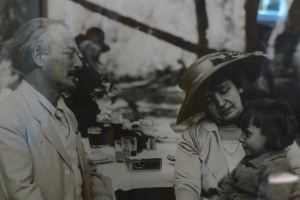
Friday November 11th 2016
Beginning of Stage II (Repertoire details see below)
Xiaoyu Liu (Yamaha) Canada He began with the Beethoven Waldstein Sonata Op.53. I felt it could have been a great deal more expressive. The Adagio molto however was beautifully controlled but became rather static under the weight of emotion being invested there. The transition to the Rondo was sensitively accomplished and the dynamics carefully moderated. I felt the extremes of dynamic he brought to this work to build the expressive emotion were unjustified and the Presto I found rather rushed. It should have been far more expressive not simply a race to the finish. The Cracovienne fantastique had an excellent provincial bouncy rhythm and has become a very attractive concert piece by Paderewski. Liu then brought his rather undifferentiated power to bear on the Prokofiev Sonata No:7. I felt the dynamic to be rather exaggerated and was less effective, however tempting. The Andante caloroso was quite moving in his interpretation. I must comment on the accuracy and clarity of the sound he produced as it was a real achievement. Such clarity brings the internal harmonic life to life, changes the associative nature of the drama with the changes in timbre.
Han Chen (Steinway) Taiwan The intensity of his approach to the music – in this case the Scriabin Sonata No: 5 Op 53 – is almost frightening. It is one of the most frequently played and owes a great deal to the orchestral Poem of Ecstasy. Lines of poetry calling the artist to life are attached to the work. Although pianistically accomplished I did not feel that the strange metaphysics of the ‘Scriabin other world’ in the single movement sonata had been sufficiently explored. The Paderewski Caprice (genre Scarlatti) was taken at quite a tempo which although exciting rather obscured the ‘Scarlattian’ nature of the piece. I kept asking myself about breathing and phrasing and this pianist’s love of extremes. The Nocturn was pleasant enough with some lovely nuances. The Liszt B Minor Sonata was an exercise in stupendous virtuosity that would benefit expressively from further exploration of what this sonata is actually ‘about’. Many of the reflective lyrical sections were beautifully brought off with a glowing cantabile tone but the rather extreme contrast with more stormily expressive passages made me feel the pianist was simply trying too hard to extract the last ‘ounce of blood’ from the score. One must give the listener time to listen…I always suggest one listens to Alfred Brendel’s early recordings of this work – a revelation in time management and expressiveness.
Yedam Kim (Steinway) South Korea This Beethoven Waldstein had a quite solid and irresistible what one might call ‘German’ nature to the sound. Again playing of high intensity and emotional commitment. I wonder what the nobleman and patron of the arts Count Waldstein would have made of it. The Adagio was introspective and genuinely thoughtful with an interesting transition to the Rondo. Technically Kim has great command of articulation and rhythm which gave the sonata tremendous forward impetus. Her left hand is a strong counterpoint to her right. In short a commanding performance. The Paderewski Au soir could have been more impressionistic but the Cracovienne fantastique exercised her formidable control of rhythm. A sheer delight.
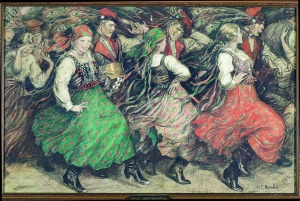
The Prokofiev Sonata No 4 in C Minor was written concerning and dedicated to Prokofiev’s close friend Maximilian Schmidthof, whose suicide in 1913 had a profound effect on the composer. There were some marvellous moments in this rather gloomy work – the second movement had an insistent almost military bass repetition that was quite striking. Kim produced a glorious tone at the beginning of the third movement which is marked Allegro con brio, ma non leggiere. A dramatic beginning to this final movement. Kim brought great authority to the task of building this fantastic drama with all its complex lyricism.
Rina Sudo (Yamaha) Japan The Paderewski Nocturne was quite expressive with a winning rubato and sweet melancholy. I love the Caprice waltz. It is such a sparkling period confection of charm and delight. Joyful waltz rhythms with glittering execution. The final Theme varie in A major is a demanding virtuoso work to have learned for the competition. She played it in rather the nineteenth-century spirit with great élan and panache somewhat in the shadow of Theodor Leschetizky. The Chopin Sonata No 3 in B minor Op. 58 was very satisfying. The opening Allegro was certainly maestoso in character with a touching cantabile central section – most poetic. The Scherzo was light, energetic and playful. The Largo beautifully poised, balanced and unsentimental, not indulgent emotionally in any way. Holding together the meditative quality of this arc of deep reflection and expression is immeasurably difficult. Of course Sudo is deeply familiar with these works having taken part in the International Chopin Competition in Warsaw. I felt there to be great nobility in the Presto which at its close is an affirmation of life’s victory over adversity. A fine performance. Why it was necessary to follow this profound expression with the Kapustin Toccatina both defeated and deflated me. After the sonata I wanted silence and did not want to hear any other music – just reflect on my thoughts.
Michelle Candotti (Steinway) Italy Candotti chose the affectingly romantic Paderewski piece Chant d’amour and later the lively Scherzino from the Album de Mai. Unapologetically undemanding music stylishly played. In the Chopin Ballade No 2 in F major she brought a fine expressive sense of drama and narrative to the work. Her tone and touch at the instrument is refined and not the slightest bit aggressive – seductive and surprisingly powerful when the music requires it. She has an instinctive understanding of the Romantic tradition in music with playing that is passionate certainly but not extreme and disturbing. The Haydn Sonata in E-flat major was full of delightful joy, humour and classical charm. The Adagio was tasteful and the cumulative energy of the jolly last movement was bursting with good spirits. Candotti is a truly musical personality of precocious talents. The Rachmaninoff Variations on the Theme of Corelli is an immense work where she gave each variation a different expressive character. Again her refined sense of colour and tone were evident. As a listener I particularly appreciate the fact she never ‘overplays’ or exaggerates to impress me – such a relief! Her motivation is to communicate and just share her love of the music with me – what more can or even should one ask of an executant?
Svetlana Andreeva (Steinway) Russia From her first appearance in Stage I, her phenomenal talents and more, her ability to communicate music directly to the heart of the listener, mark her out. The Paderewski Au Soir was charming, elegant and impressionistic. The Scherzino a delightful confection. Although her deep musicality came to the fore I suspect this music is not her most challenging. The Schumann Waldzenen Op.82 is a wonderful set of character pieces that deserves to be more often performed in recital. Again, the influence of literature in the nineteenth century romantic repertoire cannot be overlooked. Schumann defended his giving these pieces titles as he felt it would prevent misunderstandings of his intentions. Music does not always ‘speak for itself’ and require no clarification.
These are the titles:
- Eintritt (Entry)
- Jäger auf der Lauer (Hunters on the lookout)
- Einsame Blumen (Lonely Flowers)
- Verrufene Stelle (Haunted Place)
- Freundliche Landschaft (Friendly Landscape)
- Herberge (Wayside Inn)
- Vogel als Prophet (Bird as Prophet)
- Jagdlied (Hunting Song)
- Abschied (Farewell)
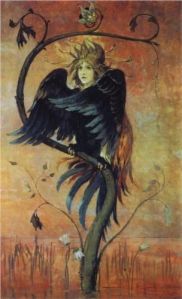
The piece ‘Lonely Flowers’ was very moving and the ‘Prophet Bird’ quite breathtaking in its metaphysical connotations as that extraordinary questioning musical phrase and answer enters the mind. Her tone and touch illuminated these pieces in a remarkable way as she becomes, when playing, so much a part of the fabric of the very score itself. Was it fanciful to imagine Andreeva, an absolute phenomeneon, had decided to dress herself as ‘The Prophet Bird’? She was wearing an extraordinary type of black silk cape/blouse reminiscent of wings. This together with her blonde hair severely drawn back cascading in an immense ponytail, an ear jewel glittering on the pale complexion of her thin frame, all gave this entire recital an authentically otherworldly even metaphysical aspect once we moved on to the Szymanowski Masques. Here literature as inspiration once again enters the picture in the guise of three famous literary characters from different eras and cultures. Scheherazade, the narrator of the Arabian tales from One Thousand and One Nights (dedicated to the Russian pianist Alexander Dubiansky) , the Tristan of the Celtic legend Tantris le Bouffon (dedicated to the pianist and pedagogue Henryk Neuhaus) then finally the Serenade de Don Juan – the great seducer (dedicated to Arthur Rubinstein). I cannot comment in detail here save to say listening to Andreeva wrestle with this magnificently complex and highly demanding work one was one of the great musical experiences of the competition so far. Astounding in a word – as is the composer.
Alexander Panfilov, (Fazioli) Russia This magnificent pianist began with Debussy’s Estampes. The Pagodes is meant to evoke the Javanese gamelan orchestra. Panfilov brought marvellous colour, variety of timbre, tone and texture to this evocation of the exotic. La Soiree dans Grenade has harmonies so evocative of Spain and Panfilov again produced beautiful nuances and colours. I felt I was walking through the hot streets of Grenada taking note of this or that Spanish scene, encountering all manner of street life. There was seemingly effortless virtuosity in the rain of Jardins sous la pluie. The Paderewski Menuet was played with great style and panache, period nostalgia and infectious rhythm. The Nocturne and its sweet melancholy benefited greatly from the warm bloom given to the sound by the Fazioli. then by far the finest Prokofiev Sonata No 7 of the competition. A complex, expressive drama unfolded in this ‘War Sonata’ with a cohesive structure and tone of definite disquiet in the Allegro inquieto. The movement was full of expressive meaning and protest. The shifting moods of the composer were delineated without excessive display or excessive declamation – all was dedicated to musical meaning. He never breaks the sound ceiling of the instrument even in the strongest forte. In the Precipitato this penetrating understanding of what the sonata is ‘about’ was clear. The musical significance of the insistent and powerful basso ostinato gave to the movement a type of monumentality, solidity and gave voice to the invincible, irresistible juggernaut of war. This perception is usually lacking in pianists seduced by the more superficial fireworks in the right hand. A brilliant and penetrative reading of this work.
Misora Ozaki (Kawai) Japan The Chopin Scherzo No 3 had a feeling of urgent neurosis about it. I felt it to be a good account of this unusual piece although Ozaki tends to ‘overplay’ on occasion. The Paderewski Menuet was pleasant but lacked any authentic period charm and understanding of the period that produced music of this type. The Legend is such a fine work, the story of a nation unfolding in nobility and song with such eloquent harmonies. An achievement of civilization this work. Ozaki presented this convincingly. Then that astonishing and spectacular work the Shechedrin Basso Ostinato. The work does not require the deepest thought and Ozaki certainly ‘gives it the maximum’. Then to the final work the Schumann Sonata in F-sharp minor Op. 11. Although authentically rhapsodic at times and coping well with the mercurial shifting moods of Schumann, I felt a great deal of expressive potentiality was being missed or left unexamined. The Aria could have had a richer cantabile character although the Scherzo was successfully lively, staccato and legato in turn as it danced along. Her full dynamic range is insufficiently explored and tends to the unrelenting and undifferentiated at times in such a long work. So many finer details of the music were overlooked in a feeling I had of ‘structural planning’. This is all very well but Schumann requires spontaneous recreation on the part of the pianist to accommodate his whimsical temperament.
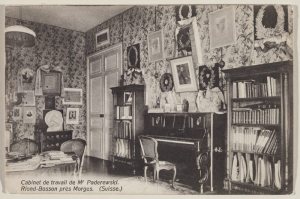
Saturday November 12th 2016
Ilya Shmukler (Kawai) Russia I am unsure that the Polonaise-Fantaisie should have such a strong dynamic at the beginning? I found his ‘expressive pauses’ slightly on the indulgent side. There was not great deal of expression within the music’s internal structure, although the mood of loss and yearning at the centre of the piece was beautifully caught and lyrically expressed. One observation on the tumultuous valedictory close – if you begin your arc of dynamic augmentation at too high a point, you will have run out of volume and have nowhere to go dynamically as you hopefully increase the tension. The Paderewski Au soir was eloquently played but I imagine it is hard for young people in 2016 to imagine the ‘period feel’ and particular charm of much of Paderewski’s music – that historical intangible we must face as musicians. Concerning the Menuet, although clearly very well performed, I suggest all the competitors watch the innocent film Moonlight Sonata that stars Paderewski as an old man in an accompanying sweet love story. There is a delightful and musically instructive scene where Paderewski plays the Menuet.
We have heard the Prokofiev Sonata No 7 many times in this competition and here it was again. Ilya certainly gave us an energetic movement full of ‘lively restlessness’ (Allegro inquieto). The Andantino was quietly nostalgic with suitable touch and tone, the agitation rising with a marked and effective accelerando to a peak of tense drama. He certainly has something to say about this piece. There was a noticeable improvisatory quality to the Andante caloroso (a ‘warm Andante’) it appeared rather like an introverted chorale with a lyrical melody. The problem with beginning a long increase in dynamic rose again leading of course to a harsh fff . The bleak cry of the single note should be far bleaker. The Precipitato was structurally clear and a powerful utterance but again the dynamic issue reared its ugly head…
Andrey Denisenko (Steinway) Russia I am sure most of these Paderewski pieces were unfamiliar to the participants before the competition. The Menuet lacked ‘period feel’ and charm. The Caprice was a lively piece executed extremely well as was the Sarabande, evocative of the period as a slow baroque dance. The Nocturne was as elegant and nostalgic for lost loves as I could imagine. If there was a prize for the best Nocturne of the competition it would go to this sensitive, rubato-filled interpretation. I felt the Chopin Polonaise-Fantaisie needed a far deeper account. Here we again encountered the problem of beginning a dynamic augmentation from starting point that is just too high.
The Brahms Fantasistücke Op. 116 were fairly new to me. Opus 116 consists of three capriccios and four intermezzos. “They are unlike any pieces he ever entrusted to piano. No longer a conversation with the audience, these were now monologues, nay, soliloquies: conversations with himself. His capriccios – violent and volatile – asked questions with no answers. His intermezzos introduced some calm into the cycle. The original idea was to close it already on the fourth miniature, Intermezzo in E major.
• Capriccio in D minor op. 116/1 is brimming with almost-chaotic energy. The endless syncopation of musical narration seems an obstinate yet pointless struggle against the invisible.
• Intermezzo in A minor op. 116/2 is a moment of repose and of reflection, singing and lyrical. Its middle part is filled with an arabesque of a melody searching for a way out. It is extraordinarily beautiful and fragile, a return to the point of departure, a melancholy dwindling of narration.
• Capriccio in G minor op. 116/3. Violence strikes back with running tones in a tempo of Allegro passionato, amplified by unisons of both hands. Trio, in E flat major, is filled with chord progressions, at times singing, at times irate.
reverie. The music wanders around the keyboard, stops and then goes on, only responding to intuition, impulse, memory.
Brahms converses with himself in tones.” (Tomaszewski)
Denisenko achieved much of what he intended except I felt he lost focus and forward momentum in the Intermezzo in A minor op. 116/2.
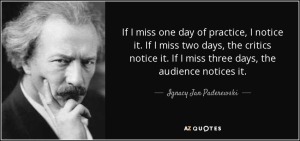
Yasuko Furumi (Steinway) Japan She began with an immaculate Mozart Sonata in D Major K.311. I would like to have seen a little spontaneity in the Allegro con spirito but it was clear that the ‘interpretation’ had been well planned in advance. The Andante con espressione is divine music but rendered almost too perfect by Yasuko. The Rondo was also ‘perfect’. Was Mozart trying to achieve the perfect Meissen porcelain figurine in sound ? At last we heard some Mendelssohn – rare enough on concert platforms today – the Fantasia in F-sharp minor Op. 28. This rhapsodic writing was well presented by Yasuko but why play repeated phrases exactly the same? She could have dwelt more on the various harmonic transitions within the work. I felt she was more ‘on’ the piece rather than ‘in’ the piece…
The Paderewski Melody op. 16 No.2 was pleasantly performed and the Caprice was a lively performance with a winning sparkle in the playing. The recital concluded with the Liszt Reminiscences de Norma (1841). The Fantasy is based on themes from a contemporary opera by Bellini which appeared in 1831 to great success. Like his Reminiscences of Don Giovanni, after Mozart, Liszt used themes from Norma not to compose a transcription or paraphrase, but to create a fantasy piece of great dimensions, suited to the piano, with no serious attempt at emulating orchestral or vocal sonorities. However, Liszt incorporates the seven different themes from the opera. It is a colourful piece and enormously difficult and virtuosic. Yasuko dispatched it in short order.
Tymoteusz Bies (Steinway) Poland Dare I say the Polish pianists are producing an idiomatic ‘Polish’ Paderewski. Here we had a lovely Melody Op.16 No 2 and Polonaise in B major Op.9 No 6. Of course the polonaise rhythm was ‘organic’ and natural rather than ‘expression applied’ but he tended to overplay the work in dynamics for my taste and it became a little coarse on occasion. With regard to that great masterpiece the Schumann Fantasy in C major Op. 17 I cannot possibly analyse the performance in detail here, but will make a few observations of a general nature. I felt Bies could try and sustain longer melodic legato lines and make much more of the glorious rhapsodic ‘songs’ in the work. He is to be admired presenting this complex creation as a competition piece and he now has it in his fingers. Overall it was fine attempt but much should now be done in detail. On occasion Bies can produce a truly beautiful tone, subtle nuances, colour and cantabile but this was not evident often enough in this vast work.

Sejoon Park (Steinway) USA This was a very demanding programme. The late Beethoven Sonata No: 30 in E major Op. 109 (1820) presents major musical, pianistic and spiritual challenges to a pianist. This is a deeply serious work and an ambitious choice for competition. The late sonatas have a spiritual content absent from shall we say the Waldstein which we have heard a number of times already. The difficult transition from the Vivace ma non troppo first movement to the Adagio espressivo and back again was well accomplished. The variations (the extraordinary fourth) that lead to the serious ending showed more than usual understanding of the composer at this difficult stage in his life. The variety of sonority required for this sonata is indeed challenging but Park has a complete technique that managed to convey the composer’s intentions. The Chopin Barcarole I found too declamatory with the usual crash of the gondola into the wharf at the beginning of this gentle romantic tryst crossing the Venetian lagoon with just a few agitated emotions between the lovers. Beautiful cantabile on occasion. Then two fine accounts of the popular Paderewski Au soir and the Scherzino.
He then gave an excellent account of the Scriabin Sonata No: 5 Op. 53. It is one of the most frequently played sonatas and owes a great deal to the orchestral Poem of Ecstasy. Lines of poetry calling the artist to life are attached to the work. Pianistically accomplished, I did feel that the strange metaphysics of the ‘Scriabin other world’ in the single movement sonata had been explored, the melody of the bare, isolated soul marooned on an arid plain of war quite heartbreaking. The Ligeti Arc-en-ciel (Rainbow) was as arresting as ever with this composer. Finally to complete this very interesting and varied programme (also an element of planning on which the jury judge) we had the utterly delightful Alfred Grünfeld Soiree de Vienne. Park produced a wonderful late nineteenth-century sound but he should enjoy the playing of this type of charming confection – not so serious! Sometimes his tone became too dense and his touch too heavy for the light-hearted nature of this entertainment. Not so intense with Grünfeld…
Tatiana Dorokhova (Steinway) Russia She opened her programme with the demanding César Franck Prélude, Chorale and Fugue (1884). Described by Adrian Corleonis as ‘ an elaborately figured, chromatically inflected, and texturally rich essay in which doubt and faith, darkness and light, oscillate until a final ecstatic resolution.’ Tatiana gave a fine account of it although occasionally falling short of its huge musical requirements. As has been often the case in the competition few young pianists have managed to master the ‘period charm’ of Paderewski. The Nocturne was perfectly satisfactory of course but lacked a ‘period condiment’. The Caprice on the other hand was energetic, sprightly, detaché with scarcely any pedal.
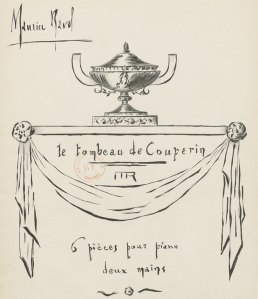
That great work, the Ravel Tombeau de Couperin was light, elegant and impressionistic conjuring up on occasion the fêtes galantes of the artist Jean-Antoine Watteau. It is in six movements based on those of a traditional Baroque suite, each movement dedicated to a friend of the composer who died fighting in the Great War. The composer later orchestrated the work. The composition successfully transforms the Couperin and more widely French Baroque idiom and style. It is an engaging piece – often calm, refined, nostalgic and reflective and gloriously ‘French’ – it was clear the pianist loves the work. A quite beautiful and tastefully understated performance with a splendid triumphal ‘Toccata’ conclusion.
Dina Ivanova (Yamaha) Russia Here we have another of the truly outstanding musical talents in this competition. Her posture and approach to the keyboard is often surprisingly intimate which gives a strongly engaging and communicative theatrical element to all she performs. The Paderewski Scherzino was dispatched with élan and the Mazurka in B-flat major she chose was possessed of so much joy, energy and style. Ravel’s Ondine had a ravishing impressionistic tone quality and feather-light evocative touch that seduced one immediately as a listener. She is a very ‘free’ player of the instrument, uninhibited and involved physically with it as well as mentally. This was evident in the ambitious choice of the Liszt B minor Sonata. She prepared herself carefully and intensely for at least a minute before striking the vital opening notes that set the tone of what is to follow. Not popular in its day (even with Clara Schumann) the sonata has gained in stature to be considered one of the greatest masterworks in the Western pianistic canon. Does it have a programme? Liszt remained silent on this issue which has given rise to multiple explanations of what it might be about – if anything tangible. Possibilities:
- The sonata is a musical portrait of the Faust legend , with “Faust,” “Gretchen,” and “Mephistopheles” themes symbolizing the main characters. (Ott, 1981)
- The sonata is autobiographical; its musical contrasts spring from the conflicts within Liszt’s own personality. (Raabe, 1931)
- The sonata is about the divine and the diabolical; it is based on the Bible and on Milton’s Paradise Lost. (Szász, 1984)
- The sonata is an allegory set in the Garden of Eden; it deals with the Fall of Man and contains “God,” “Lucifer,” “Serpent,” “Adam,” and “Eve” themes. (Merrick, 1987)
- The sonata has no programmatic allusions; it is a piece of “expressive form” with no meaning beyond itself— a meaning that probably runs all the deeper because of that fact. (Winklhofer, 1980)
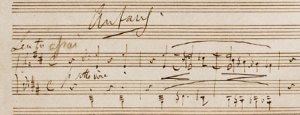
This was a very expressive performance. She never became over-excited or lost control of her dynamics or tempi and adopted a very logical approach in many ways. She has a marvelous burnish to her piano tone and great variety of articulation and touch depending on the context. Dina has an all encompassing technique and lives every musical second in her vivid imagination. One certainly experiences a moment of heightened reality when she performs. However it has always disappointed me that young players always want to perform this work ‘at the maximum’. This for the listener is exciting I suppose at a basic physical level but there are other dimensions to music than velocity and dynamics. She was guilty of this occasionally. A marvellous actress as well as a superfine pianist – a musical muse for some and inspiringly pre-Raphaelite in beauty.
Andrzej Wierciński (Steinway) Poland I loved his very ‘Polish’ Paderewski – a sensitive Nocturne and a stirring, lively and virtuosic Caprice with exciting and varied articulation. The Chopin Scherzo No: 3 in C-sharp minor was at once a fine and noble account approaching grandeur at the conclusion. Dedicated to his pupil Adolf Gutman, this was last work the composer sketched during the Majorca sojourn and in the atmosphere of Valldemossa. Chopin was ill at the time which interrupted and perhaps affected the writing. ‘…questions or cries are hurled into an empty, hollow space – presto con fuoco.’ (Tomaszewski). Then to the Prokofiev Sonata No: 7 in B-flat major p. 83 The despair and anger that suffuse this second of Prokofiev’s “War Sonatas” was well captured and penetratingly expressed. I would like to have had rather more dynamic variation and perhaps a slightly faster tempo as the constant strong dynamic became tiring. He took the Precipitato movement at a rather moderate tempo compared to what we have heard from other participants but it did not bother me in the least. A very promising Polish talent certainly.
Sunday November 13th 2016
Kosuke Akimoto (Kawai) Japan As you will know if you have read my previous review of this artist, I have the greatest respect for is musicianship and intelligence. This was only confirmed by this afternoon’s splendid recital. The Paderewski Au soir was intensely romantic – charming and absolutely ‘period’ (one of the few). The Cracovienne fantastique had an excellent variety of approach to the repeated theme and rhythm. An excellent interpretation of changing moods and altered energies. there was an imaginative and appropriate accelerando at the conclusion. By far the best rendition of this piece in the competition. We moved on to the Brahms Variations on a Theme of Paganini Op. 35 Bk II. The two books are based on Caprice 24 by Paganini. David Dubal wrote: To play them requires fingers of steel, a heart of burning lava and the courage of a lion. Here we had extremely authoritative playing with enviable legato and cantabile. His tone and touch present the listener with great transparency and clarity at the keyboard. The full, rich Brahmsian tone was available when required and the rhapsodic Brahms wonderfully controlled in terms of tempi and dynamics.
Finally a highlight of the competition so far for me, the Rachmaninoff Sonata No 2 in B-flat minor. From the powerful and noble opening I knew this was to be an exceptional interpretation. It was a spontaneous recreation and outstandingly expressive reading. I could hear the magnificent Orthodox bells of Kiev and St. Petersburg accompanied by superb accelerations of nervous energy, The huge forces he unleashed were never permitted to break through the sound ceiling of the instrument while he is leading the listener to some harmonic destination. There were long dramatic silences where only the decaying resonance of the piano filled the hall. Akimoto was meditative and reflective in sections of the sonata where I had never experienced such reinterpretations or recreations before. In an improvisatory fashion he seemed to be searching for harmonic resolutions. Then the tremendous dynamic climb of the coda. One of the greatest performances of this sonata I have ever heard – and that is saying something!
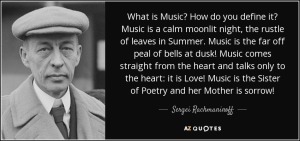
Hyuk Lee (Steinway) South Korea This was a very fine performance of the Bach/Busoni Chaconne in D Minor, BMV 1004. It possessed a more transparent texture than usual and never became a noisy farrago which can be the case. Noble sentiments were presented here. I felt the dynamic could possibly have been more varied as we approached the conclusion. I was disappointed in the Paderewski Cracovienne and found it rather perfunctory. The work needs to breathe and the rhythm was not sufficiently that of the Polish dance. For such a young pianist (16) he had the temerity to approach the Brahms 2 Rhapsodies Op. 79. The B-minor was blessed with an eloquent cantabile and lyricism to balance the more agitated sections. The G Minor was a highly passionate utterance but strangely I was not particularly moved – perhaps I am tired.
The phrasing of the theme was not sufficiently noble for me. We then returned to Paderewski and Melodie. What an excellent feature of programming to separate the two which elegantly breaks up the blocks of serious music . Not many participants did this so he will be awarded points by the jury. The Liszt Mephisto No 1 was expressed with quite phenomenal finger dexterity, breathtaking virtuosity and rhythmic drive – effortless. The more expressive sections were presented with a glowing tone and finely wrought legato lines with some very creative ideas. The cumulative energy was quite towards the coda was quite fantastic. Sometimes I needed to search my mind for the musical meaning but quite honestly I was simply carried along on the tsunami of sound.
Gi Taek Lee (Steinway) South Korea He opened his programme with a sweet enough Au soir. Then onto the Schumann Humoreske in B-flat major Op.20. In a review of this nature I cannot analyse his performance of each of the seven sections save to say that the emotional tone he brought to each was decidedly different. “All week I’ve been sitting at the piano and composing and writing and laughing and crying, all at the same time,” wrote Schumann to his beloved Clara Wieck from Vienna in March 1839. “You will find this beautifully illustrated in my Opus 20, the great Humoreske.” I find this work hard to fall in love with despite the Schumannesque rhythmic drive, complexly contrived harmonies and tender songs. I felt Lee’s tempi to be simply too exaggerated and lacking in musical meaning (probably due to his astonishing finger dexterity). I remain unmoved throughout – a real disappointment with this interpretation which lacked irony and whimsy – the very nature of the work.
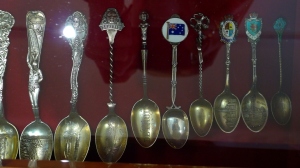
Then the Paderewski Scherzino with which I feel he was not particularly at home. Finally another performance of the Prokofiev Sonata 7 in B-flat major Op. 83. Great clarity and transparency of sound but the tempo indication of the first movement is Allegro inquieto which translated into English means ‘Lively and restless’. The translation of indications like this into different languages often gives rise to misunderstandings and lack of standardization of meaning. The movement is not Allegro con fuoco which seems to have tempted so many in this competition. A great deal of intensity here but lacking in sufficient authentically expressive elements. Again Andante caloroso translates into English as ‘ going or proceeding warmly’ which is rather difficult to interpret at the keyboard at the best of times. The bleak notes repeated at the near centre of this movement are surely an expression of the loneliness of the human soul isolated spiritually by war and crying out in despair and anguish. I searched for the musical meaning of his account of the sonata. To quote the great Ignaz Friedman ‘There are the notes, but there is what is behind the notes and there is what is between the notes.’ The Precipitato of course was highly virtuosic as anticipated but the melodic musical meaning contained latently within seemed to have little meaning for this pianist.
Jakub Kuszlik (Steinway) Poland The Paderewski Au soir was charmingly and sympathetically presented as was the idiomatic Scherzino – all rather Polish. The programme Kuszlik arranged had definitely been given some penetrating thought by the pianist which will endear him to the jury. Liszt composed piano transcriptions of some fifty of Schubert’s songs. Kuszlik played the Schubert/Liszt song Wanderer first to prepare us for the piano Fantasy proper, the theme of which is based on the original song. The Wanderer Fantasy in C major Op. 15 by Schubert then followed. This was a competent account of the Fantasy but I yearned for a more melodic and expressive legato line on many occasions. He stayed pretty well at the same dynamic which I found rather tiring. So many opportunities for poetry and expressiveness were missed and the conception of the work came across to me at least as rather prosaic.
Liszt’s version of Gretchen am Spinnrade (‘Gretchen at the Spinning Wheel’) is probably one of the most famous. Liszt is faithful to the vocal line and the accompaniment. The mood of the song depicts Goethe’s Gretchen spinning incessantly, her memories of Faust building to the moment of their kiss. At which point both Gretchen and the spinning wheel collapse. Kuszlik managed to capture the spirit of this transcription of the song well.
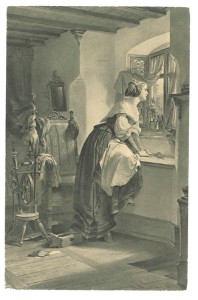
The Liszt Mephisto no 1 which followed the same literary track was impressive as a virtuoso piece with an exciting conclusion but again I felt the musical meaning of this work needs a great deal more attention. However all this being said Kuszlik is a very promising and clearly analytical talent that simply requires a more sophisticated direction of his musical poetic, sensibility and aesthetic sense.
Elżbieta Bilicka (Yamaha) Poland She began with a piece entitled ‘Legende’ Op. 16 No 1 from the group Miscellanea. There are reminiscences of Chopin’s Ballades in that both the ‘Legends’ that Paderewski wrote are patriotic and a narrative in absolute music. The Scherzino was light-hearted and joyful just as a scherzo should be. The Ravel Miroirs was an excellent choice for her particular temperament and abilities. She clearly loves this piece. Maurice Ravel had joined a group of avant-garde young artists, poets, critics, and musicians known as Les Apaches or ‘hooligans’. Ricardo Viñes came up with this evocative name for his group of ‘artistic outcasts’. Each of the five pieces that make up the set was dedicated to one pf the ‘Apaches’.
- Noctuelles (‘Night Moths’).
- Oiseaux tristes (‘Sad Birds’).
- Une barque sur l’océan (‘A Boat on the Ocean’).
- Alborada del gracioso (‘Morning Song of the Jester’).
- La vallée des cloches (The Valley of Bells’).
These seductive impressionistic paintings in sound were well served by her fine technique which utilized many changes of timbre, articulation, tone and touch to achieve the different mood qualities of the Miroirs. A deeply satisfying recital articulating the sensibility and sensuality of French music.
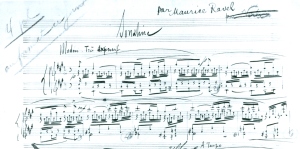
Xiaohui Yang (Steinway) China Her striking appearance sheathed in a red silk gown put me in mind of the significance of the colour red to the Chinese. Red corresponds with fire and symbolizes good fortune and joy. The colour symbolizes good luck. She began with a superb account of the Bach Partita No 5 in G majo. Wonderful sound and articulation, scarcely any pedal and used judiciously. The Gigue was a delight with its sprung rhythms. I felt that the Paderewski lacked ‘period charm’ for all the reasons outlined above. However the Caprice Waltz was full of glittering flourishes and an energetic ‘call to the floor’ (to dance). She presented it as a really charming virtuoso confection with style, élan and panache. The Rachmaninoff Moments Musicaux were rhapsodic, passionate and intense building to a mighty edifice of sound. He said in an interview: ‘What I try to do, when writing down my music, is to make it say simply and directly that which is in my heart when I am composing.’ Each Moment reproduces a musical form characteristic of a previous musical era – nocturne, barcarolle, etude…Many are familiar as individually performed works rather than as an entire set. The final Moment ‘Maestoso’ is rather heavily virtuosic in the nineteenth century sense but retained its rhapsodic mood and incredible exploration of all the sonorities the piano can produce. The pianist showed extraordinary stamina and powerful technique in this particular work.
Anatolii Kostiuchenko (Yamaha) Ukraine I was terribly impressed by his authentic grasp of rhythm and idiom in the two Polish Dances of Paderewski that he chose – the Mazurka in A major and the Polonaise in B major. The Brahms Ballade in D minor Op.10/No 1 was also a fine interpretation with rich Brahmsian tone. The Beethoven Waldstein Sonata was taken at an excellent moderate tempo. He tends to a slight ‘untidiness’ in his playing which will probably count against him in competition but does not bother me particularly. I much prefer this to a gabble I cannot follow – here I can follow what Beethoven is actually doing harmonically. The Adagio was very considered, meditative and thoughtful. The Prestissimo was all the more effective because of the moderation exercised in the preceding tempos. The Scriabin Sonata No 4 is an interesting choice as it is certainly ‘other-worldly’ Scriabin. He wrote a programmatic poem for this work concerning flight to a distant star. A deeply philosophical and rather strange work in inspiration.
Thinly veiled in transparent cloud
A star shines softly, far and lonely.
How beautiful! The azure secret
Of its radiance beckons, lulls me …
Vehement desire, sensual, insane, sweet …
Now! Joyfully I fly upward toward you,
Freely I take wing.
Mad dance, godlike play …
I draw near in my longing …
Drink you in, sea of light, you light of my own self …
I felt that Kostiuchenko is a real artist and in many ways of a temperament not suited to more ‘commercial’ idea of competitions. He delineated the neurotic shifting moods of this work with rare understanding and the ecstasy of joy was unmistakable. I fear he may not pass to Stage III only because he has a different philosophy towards competitions….I may be completely wrong of course!
Participants accepted to the Semi-Final
Liu Xiaoyu Canada 08.05.1997
Andreeva Svetlana Russia 16.12.1988
Panfilov Alexander Russia 13.04.1989
Bies Tymoteusz Poland 09.06.1995
Ivanova Dina Russia 25.12.1994
Akimoto Kosuke Japan 10.05.1993
Lee Hyuk Republic of South Korea 04.01.2000
Kuszlik Jakub Poland 23.12.1996
Bilicka Elżbieta Poland 10.11.1992
Yang Xiaohui China 24.09.1991
Tuesday November 15th 2016
Xiaoyu Liu (Yamaha) Canada The work Scrabble by Z. Bargielski is what one might term an ‘indeterminate work’ in that the pianist is given musical fragments, elements or modules to play with as he wishes with various rules of engagement and personal compositional input. This means the outcome with each pianist will be different. I find it so hard to judge so I will give a score out of 10 on a superficial impression – deuced unfair! (7)
In the Schumann Carnaval he delineated each ‘character’ in this inspired Commedia Del’Arte very well. However I did feel a great deal more could be done to extract gold from this rich load of musical ore. There are so many opportunities for the piano to sing in this work. There was fine articulation with sparing use of the pedal and finger legato. Excellent rhythmical variety capturing the whimsical, mercurial nature of this composer. However I felt the conclusion far too ‘symphonic’ for a Commedia Dell’Arte performance. I liked the Ravel Alborada del gracioso from Miroirs with its evocation of paintings of Spain, a wander through the colourful street life. Sonority was altered with both pedals – excellent idea. The lighter treasure in this recital but nevertheless terrific (in the popular meaning of this word) The Kapustin Variations for piano Op.41. Remember Duke Ellington? It don’t mean a thing, if it ain’t got that swing. Terrific innate sense of jazz rhythms and improvisation reminded me so much of Oscar Peterson (a trained classical pianist incidentally). Xiaoyu must be great fun at a party!
Svetlana Andreeva (Steinway) Russia I thought her Scrabble brilliant, dramatic and cohesive (10). The Beethoven Sonata No 2 in C-minor Op. 111 was a tremendously ambitious choice that very convincingly plumbed many of the depths. Here Beethoven combines sonata and fugue textures in the first movement, something only Mozart had approached solving before him. The tragic nature of the sonata was evident with Andreeva from the outset in the Maestoso introduction. I have no space here to give the interpretation the attention it richly deserves save to say the nobility of the playing affected me greatly. The remarkable Arietta – Adagio molto semplice cantabile and its destiny, so like that of a human life, was meditative and ‘simple’ in mood from the outset. Each variation increases in speed but the pulse remains profound. The refinement of the last page – pianissimo and ‘of diaphanous delicacy’ (Charles Rosen) – the simple modest statement contained within the final chord after the increasing emotional agitation that has preceded it, has given rise to all variety of artistic and philosophical inspirations.
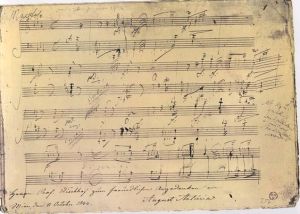
Early in the one of my favourite novels, Dr. Faustus by Thomas Mann, when Leverkühn and Zeitblom are high school students, Kretzschmar gives a lecture on Beethoven’s last piano sonata Op. 111. He comments on the ‘polyphonic objectivity’ of Beethoven’s late music. He then explains the motif of the Arietta. When the variations have reached the incredible climax that Stravinsky called the ‘Boogie Woogie Variation’, Kretzschmar comments on the passage of long trills indicating the barren field of the soul’s isolation. “’These flourishes and cadenzas! Do you hear the conventions that are left in? Here – the language – is no longer – purified of the flourishes – but the flourishes – of the appearance – of their subjective – domination – the appearance – of art is thrown off – at last …” At the end the motif becomes calmer and more extensive, expanded to a more consoling version and resignation to fate. There could never have been a third movement. Andreeva despite her youth understands this it seems to me.
Then to No 11 of the Messaien Vingt regards sur L’Enfant Jesus. Rarely performed it simply confirms the rare Andreeva psyche. She had such authority over these fiendishly difficult birdsongs as they rang out (a collecting passion of the composer who incorporated them from all over the world in his music). Quite fantastic. Marvelous changes of timbre and an understanding of how silence can be pregnant with meaning. A pianist genuinely transfigured at the keyboard.
Alexander Panfilov (Fazioli) Russia Scrabble (8). With this work we suffered a broken string in the treble which caused some consternation and delay. He returned to play the Mussorgsky Pictures at an Exhibition even with the string not replaced. I was not enamored of this performance despite my previous enthusiastic notes on this pianist. I felt the tempo of the walk through the exhibition, as initially stated, as simply too fast. Also insufficient variation in the sound pictures that we were experiencing and their significance. Powerful playing certainly but undifferentiated interpretatively for me.
Tymoteusz Bies (Steinway) Poland Scrabble (8) After this he embarked on the Chopin Preludes op. 28. I cannot analyse each one here but a rather dreamy, reflective and nostalgic account of the preludes compared to some ‘high voltage’ accounts. No specific individual interpretative voice emerged and the quality became increasingly variable as the cycle progressed. No details. This is a tough competition and the stresses are enormous.
Dina Ivanova (Yamaha) Russia Scrabble (10) She passed on from this to the Debussy Estampes. The Pagodes reminded me of the gamelan orchestras I heard when I visited Java – a wonderful evocation. The La soiree dans Grenade seemed to me to utilize Arabic musical modes or imitations of them. She has a truly sensual body language when interpreting these pieces – not celebrity overt sexual display or suffering contorting her features, just deep involvement in the fabric of the music with tremendous integrity. In other words an artist and not simply a pianist. So musical! She clearly loves water and its transmutation on the keyboard. The Jardins sous pluie was superbly impressionistic of rain with glorious tone, touch and never a wrong note. She completed her recital with Stravinsky’s Petrushka. The ballet tells the story of the loves and jealousies of three puppets. This pianist is a wonderful actress and apart from delineating the agonies of the puppets on the piano she became them in a way, a marionette herself. Her playing was effortless and joyful, technique the servant of expression always. Even in FF passages she never breaks the sound ceiling of the piano or produces an ugly sound. What a treat that recital was!
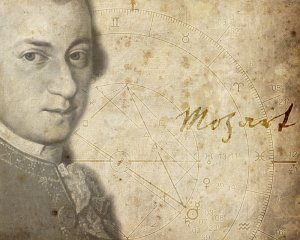
MOZART CONCERTOS
Kosuke Akimoto (Kawai) Japan Concerto No 20 in D minor K.466 This is one of the best known of the concertos. Mozart here released the ‘daemonic’ element in his music which in fact anticipates the romanticism of the following century. The pianists are performing with a chamber orchestra and are of course very exposed in their musicianship – as this is Mozart. However I felt this orchestra (the Capella Bydgostiensis conducted by Kai Baumann) lacked any passionate, ‘driven’ element. After his majestic Rachmaninoff I was surprised at how far Akimoto toned down his approach to Mozart – perhaps too far. He had good communication with the orchestra but he seemed far too contained and ‘four square’ for this particularly dramatic concerto.
Hyuk Lee (Steinway) South Korea Concerto No 21 in C major K. 467 This concerto followed the D minor by only a month but what a contrast of mood! Lee produces a superb tone for Mozart and the Allegro maestoso was certainly rather grand, expressive with eloquent phrasing The piano almost avoids involvement with the themes of the orchestra in this first movement. The cantabile Andante must be one of the most beautiful – like a glorious aria floating above us. I noticed the jury has d all sat back and were simply listening to this beautiful piano sound produced by Lee. Of course I associate it strongly with the 1967 Swedish film Elvira Madigan which depicts the most tragic of love stories not dissimilar to another at Mayerling. The high spirited Allegro vivace assai was carried well by the soloist – glittering and urgent. His varied phrase lengths gave forward momentum and repeated phrases were varied in the repeat – rare enough. the cadenzas may have been his own but were not distinguished n any way.
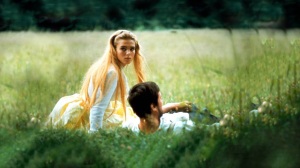
Jakub Kuszlik (Steinway) Poland Concerto No 17 in G major K. 453 Mozart wrote this work for his pupil Barbara Ployer in 1784. The two themes that open the work are rather gentle in nature. The genre is clearly operatic but we saw little of these shadows. The Andante is expressive and charmingly played. In the spring of 1784 Mozart jotted down in his notebook the song of a starling that he heard that was for sale. ‘That was beautiful’ he allegedly commented. He purchased the dear bird and when it died he actually buried it in the garden with a poetic epitaph. The final happy Allegretto movement suggests so strongly Papageno in Die Zauberflöte. The coda as the rumbustious excitement of the final act of a Mozart opera. A very good performance. The jury became quite animated during this movement all tapping away silently with their fingers, denied their opportunity to shine as soloists. How Mozart is loved!
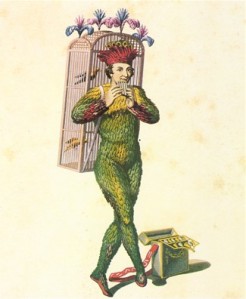
Elżbieta Bilicka Poland Concerto No 15 in B-flat major K. 450 Mozart wrote that he composed this concerto for himself and that it is ‘bound to make the performer perspire’. There is quite an element of bravura in the opening Allegro which Bilicka expressed with style, élan and panache. She had an excellent rapport with the orchestra. The development requires quite some virtuosity, certainly by 18th century standards. The Andante is not a mood piece but rather unsettled with a particularly interesting theme. The final movement Allegro again provides the performer with bravura virtuosic challenges and Bilicka coped with the episodes that require difficult crossed hands terribly well and convincingly. She brought it off with expressive joy and playfulness. A fine performance.
Xiaohui Yang (Steinway) China Mozart Concerto No 23 in A major K. 488 This was a simply divine performance. The crystalline transparency of her sound is ravishing, her phrasing ‘ to die for’ (excuse the Hollywood language but it is apt). The Allegro was perfectly Mozartian in terms of tone, touch, period style and that indescribable magic element in music that distinguishes a good performance from a great one. The piano confines itself here to elaborating orchestral themes. The Adagio is surely one of the most heart-rending and poignant movements Mozart ever wrote. The only movement in F sharp minor – my favourite key incidentally. Yang was simply sublime in this – I do not use the word ‘perfection’ lightly and so rarely but this was the finest of poetic flights imaginable. The crystal of her sound filled the hall. The tragic mood is all pervasive – simple yet profound in depth – one of the great utterances of Western civilisation on the nature of mortality and grief. The Allegro assai blows away the moody old clouds with supremely effective invention and energy. Yet the nature of the sublime that had transfigured us was suddenly visited by the devil. Whether the fault of the conductor or simply a sudden blank was impossible to determine but Yang suddenly lost direction. The fumbling was all the more deeply shocking because of the heavens that had already opened. But for me this was simply human fallibility, the dual nature of this dream we call life. The incident made not one jot of difference to my feeling that this was the second finest performance of the entire competition – the other being the Rachmaninoff sonata of Akimoto. Can the jury members overlook it? It all depends on their character, empathy and temperament. The incident was a useful corrective to the assumption that human nature can be perfect. In fact we can aspire to perfection, it occasionally visits us but we can assume nothing even after the most careful of preparations. Luck plays its horrid part…
Wednesday November 16 2016
MOZART CONCERTOS
Xiaohyu Liu (Yamaha) Canada Concerto No 19 in F major K.459 In this concerto the piano plays rather a subordinate role to the orchestra. It possesses few virtuoso elements. The Allegro reminds me of an operatic overture it so ‘conversational’ in tone. Liu had lovely phrasing was expressive and a skillful use of finger legato rather than the pedal. I felt it too ‘four square’ and prepared for me – wanted a little more spontaneity and forward urgency. The orchestra and its amateur nature is really beginning to depress me in the introduction to the second movement. The Allegretto is good humoured and rather delicate. Liu was rather musically sensitive here. In the final Allegro assai the concerto indulged the operatic idiom once again with jolly humorous exchanges between soloist and orchestra – very high spirited. Exuberant in a word. There are outbursts of bravura playing, however I felt there was not a great deal of musical meaning extracted by the pianist considering the enormous contrapuntal skill Mozart employs in this irresistible movement.
Svetlana Andreevna (Steinway) Russia Concerto No 27 in B-flat major K. 595 Mozart’s last piano concerto (1791) completed eleven months before he died. Less brilliant music for the soloist and toned down orchestration compared to many other concertos but poignant. Expressively I felt the Allegro did not start well and was over-pedaled for the ‘classical’ style. However she improved as the movement moved on. The Larghetto is a ‘seemingly artless tune’ to which Andreeva gave nostalgia and grace. Excellent phrasing but I felt it could still benefit from less restrained expression. The Allegro rhythmically bounces along again with operatic shadows. Could I detect Dorabella’s aria in Act II of Così : ‘È amore un ladroncello’ ? Mozart leaves a pianist so exposed it is a real test in any competition. There are moments of symphonic fullness which becomes more triumphal as the movement proceeds. I felt as rather ‘ a loner’ she did not really connect intimately with the orchestra or conductor. The conclusion was not transparent enough for me, but perhaps that is because of my experience playing fortepiano which has hammers covered in deerskin and not felt. The sound could not be more different.
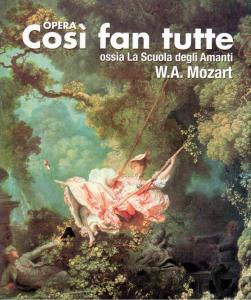
Alexander Panfilov (Fazioli) Russia Concerto No: 23 in A major K. 488 C.M. Girdlestone described the opening Allegro as ‘having the light of a March day when a pale sun shines unconvincingly through fleeting showers.’ This lackluster orchestral opening was an extraordinarily dull and cloudy day. Clearly Panfilov has had experience playing with orchestras (perhaps even this concerto). He had a good grasp of style and his ‘Russian’ tone has a seductive bloom (assisted by the rich Fazioli ). However I felt he was simply ‘going through the motions’ here and doing little with the notes. The Adagio had scarcely any sense of pathos, grief or tragedy – prosaic in a word. The Allegro assai revealed the fairly poor instrumentalists in this orchestra – under-rehearsed as a band. The gay operatic tune had a certain springy rhythm and a higher degree of elegance and style compared to what had preceded it. However repeated phrases were repeated in exactly the same way with no variation. So little expression and too heavy by half. I was terribly disappointed…
Dina Ivanova (Steinway) Russia Concerto No: 23 in A major K. 488 . The pianist came onstage wearing a stunning red sheath dress that did wonders for audience interest in the proceedings. Even the conductor came to life! Warmth and love. All the opening phrases were so eloquent and full of subtle and theatrical gesture. Such a stylish player who communicates well with the audience (and orchestra) in quite an intimate way. The heartbreaking Adagio was poetic and eloquent but tasteful and not indulgent yet tragic and laden with grief – a remarkable balancing act of sensibility. The explosion of joy and exuberance in the final Allegro assai was all the more forceful because of this. Again operatic in its colorful , festive and energetic close. Is she in danger of becoming over-theatrical? Probably with her temperamentvoll personality – but we love such warmth and sheer joy in playing the piano all the same!
Tymoteusz Bies (Steinway) Poland Concerto No 20 in D minor K.466 There is an expression in English ‘Give it some welly!’ which is associated with the victorious Wellington boot during the Napoleonic Wars and means ‘give it some energy, concentration or committment!’ The opening with this orchestra and conductor was absolutely dead of passion – this concerto being a pre-cursor to full blown Romanticism. Where was the ‘daemonic element’ that Mozart released here? The opening Allegro should be dark with premonition in the dramatic spirit of the threatening Commendatore from Don Giovanni. The Romanze was pleasant enough I suppose. Bies is a naturally good communicator and excellent pianist. He really tried with this orchestra – the conductor even resorted to conducting the pianist on occasion – intolerable. I felt sure Bies felt frustrated with the lot of them. The sonata rondo of the finale was all rather perfunctory to my ear.
Kosuke Akimoto (Kawai) Japan I thought his Scrabble an excellent invention and gave him dix points. In his intelligent way he dovetailed the tonality directly into the opening of the Liszt B-minor Sonata. I think this was a mistake as the opening of the B minor is a dramatic beginning that should emerge from silence for its full dramatic effect. It was a measured performance with moments of beautiful cantabile. However the dynamics tended to the rather unvaried which often resulted in rather too extreme contrasts to my taste. In one of many possible readings, this work can sometimes seem to me like a great Ballade in the eighteenth century (yes) sense of the term ballade, used to describe narrative poetry. Except in this case absolute music took the place of a narrative in language. Liszt did not call it thus but sometimes among the many possibilities, this idea flickers through my mind. The fugue had great solidity. I was happy with this fine performance, although many expressive opportunities were missed on too many occasions due to the virtuosic demands and their misleading nature for young pianists – quite normal in such a vast work. Again this lead into a somewhat undifferentiated account of the Scriabin Fantasia in B-minor p. 28 – beautiful cantabile in the song-like main theme. However it is all too easy to get lost in the baroque developments of this fantasia…
Hyuk Lee (Steinway) South Korea Scrabble (8) The Chopin Sonata No 2 in B-flat minor, Op. 35. Being such a young piano prodigy he plays the notes brilliantly and has assimilated interpretative gestures or what one might unkindly call ‘received expression’. But as for an individual vision – not just yet but it will surely come. For example the Marche funèbre was certainly tragic and the central reflective section beautifully cantabile but I was not greatly moved. Of course that is where the magic of making music lies. One has to be immersed not only in the notes and the context but have experinced much of life itself. The Prokofiev Sonata No 7 in B-flat major Op. 83 on the other hand as a ‘War Sonata’ does not require the same type of ‘experience of life’ to interpret as the Chopin. He has marvelous control of articulation, duration and dynamics and actually began the work according to the direction inquieto (‘restless’) rather than dynamically overblown. However that unfathomable grief, bleaker than bleak, that lies within the lonely isolated notes of the Andantino escaped him. The best performances of this much performed work in the competition since Panfilov, perhaps better.
Jakub Kuszlik (Steinway) Poland Scrabble – excellent (9). Kuszlik began with the Szymanowski Masques. Here literature as inspiration once again enters the picture in the guise of three famous literary characters from different eras and cultures. Scheherazade, the narrator of the Arabian tales from One Thousand and One Nights (dedicated to the Russian pianist Alexander Dubiansky) , the Tristan of the Celtic legend Tantris le Bouffon (dedicated to the pianist and pedagogue Henryk Neuhaus) then finally the Serenade de Don Juan – the great seducer (dedicated to Arthur Rubinstein). I cannot comment in detail here on this magnificently complex and highly demanding work save to say listening to Kuszlik was only very slightly less spectacular or authoritative than listening to Andreeva wrestle with it. I am afraid I did not respond well to the early Chopin Variations on La ci darem la mano. I felt it was not sufficiently ‘classical’ and rather over-pedalled for this early styl brillant work. Also the Mozartian operatic aria idiom was slightly astray. Of course this is all so personal but I like Chopin’s early styl brillant works to glitter and sparkle with energy, lightness and elegance far more than Brahms ever dreamed of.
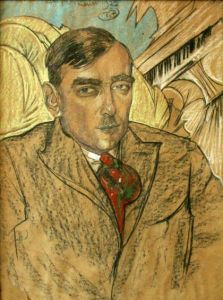
Elżbieta Bilicka (Yamaha) Poland Scrabble – absolutely brilliant (10). The first of the Scriabin Two Poems Op.32 had a sensitive touch and fine legato as well as rather rhapsodic delineation of the melody. The second was ardent and passionné however tending on occasion to a harshness of tone. The Schumann Humoreske in B-flat major Op.20 came off terribly well. In a review of this nature I cannot analyse her performance of each of the seven sections save to say that the emotional tone she brought to each was inspiringly different. “All week I’ve been sitting at the piano and composing and writing and laughing and crying, all at the same time,” wrote Schumann to his beloved Clara Wieck from Vienna in March 1839. “You will find this beautifully illustrated in my Opus 20, the great Humoreske.” I usually find this work hard to fall in love with despite the Schumannesque rhythmic drive, complexly contrived harmonies and tender songs. However on this occasion apart from one or two moments this feeling was completely reversed. Her interpretation contained irony and whimsy – the very nature of the work
Xiaohui Yang (Steinway) China A fine extended version of Scrabble (10). The Ravel Sonatine is not so named because it is easy to deal with at the keyboard. Perhaps I love this work so much as it is imbued with late eighteenth-century musical elegance and classical structure. Her tone in this work (that preceded Miroirs) was as transparent as fine crystal. She is a subtle performer and deeply musical. There is great authority in her playing. She was brilliant in the difficult final movement which is a toccata related to the works of the French claveciniste composers (Rameau and Couperin). Ravel would later enlarge this toccata to become the virtuosic Toccata of Le tombeau de Couperin. The Schumann Sonata No 1 in F-sharp minor Op.11 is a difficult competition choice and a fiendishly difficult work to bring off convincingly. Although rhapsodic at times and coping well with the mercurial shifting moods of Schumann, I felt a great deal of expressive potentiality was being missed or left unexamined. The Aria could have had a richer cantabile character although the Scherzo was successfully lively, staccato and legato in turn as it danced along. Dynamic Her tremendous dynamic range was insufficiently explored and tended to be unrelenting and undifferentiated at times in such a long work. So many finer details of the music were often overlooked. Schumann always requires spontaneous recreation on the part of the pianist to accommodate his whimsical temperament.
Participants accepted to the Final
Svetlana Andreeva
Dina Ivanova
Hyuk Lee
Jakub Kuszlik
Elżbieta Bilicka
Friday November 18th 2016
I really dare not give an opinion on the Jury’s final decision as so many unknown factors come into play. On the face of it I think it was a wise decision but of course there were my favourites who became casualties of the various stages. At all events it will be lovely to hear the Paderewski Concerto for the first time in the competition’s history.
Svetlana Andreeva (Steinway) Brahms Concerto No 1 in D minor Op. 15 The first Maestoso movement was noble enough but at the slowish tempo that the conductor Tadeusz Strugała adopted, the panoramic grandeur of the opening was diminished and the forward momentum of the monumental movement lacked the characteristic feeling of implacable power. There were many passioné entries and exciting playing from Andreeva. She had good communication with the conductor. However, I began to feel as the movement progressed that this concerto was possibly an over-ambitious choice for a competition. She seemed to be playing at the very limits of her abilities, great as they are, for much of the time. The tempo of the Adagio I also found rather laboured with an absence of the ardent rhapsodic. However at times it became lyrical and eloquent but this was unfortunately intermittent for me. The Rondo was a truly welcome explosion of energy on the part of both the soloist and orchestra. Andreeva gave total commitment to this movement which was a magnificent effort as it was clear she was also suffering from the virus which has beset the entire competition.
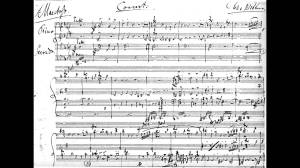
Dina Ivanova (Yamaha) Liszt Piano Concerto in E-flat major S.124 There was an incident at the beginning which is pointless to dwell on now. The complexity of the harmonies in the first pages of this work is astonishing. Much more could have been made of them. This piano concerto, like many works of Liszt, works towards a final culminating presto of formidable excitement. For this to have its full impact one must carefully calculate what tempo to begin the Allegro maestoso. The temptation of course for young pianists is to launch in with death-defying tempos and then there is nothing, no expressive space left at the end to accommodate the presto (this after an illuminating discussion over breakfast I had on the piece – not the pianist – with Tamás Ungár, one of the jury members). I felt this was the case here in the first movement, spectacular though it was. This was followed seamlessly by the Quasi adagio-Allegretto vivace-Allegro animato. After a beautiful and lyrical ‘quasi-adagio’ performed by Ivanova, it was followed by the unaccustomed sound of the triangle that heralds the rather ‘jokey’ character of the ‘Allegro animato’. All this was well accomplished yet I still felt a great deal more (by both orchestra, conductor and soloist) could be made of the fabulous details and implications lying in wait within Liszt’s writing. In the final Allegro marziale animato the performer was seduced into tremendous displays of virtuosity but at perhaps too fast a tempo too early to achieve the great dramatic impact of the presto finale Liszt was looking for. Various themes are reintroduced in various guises but the temptation is to accelerate too early. We were rather denied Ivanova’s theatrical joy at the instrument which was somewhat muted owing to the incident at the beginning.
Hyuk Lee (Steinway) Rachmaninoff Piano Concerto No 2 in C Minor op. 18 This precociously young pianist (16) digitally completely dominated this work in an astonishing display of virtuosity. All he needs now is to mature as a person and bring that maturity to bear. We can look forward to a great pianist and a glittering future.
Saturday November 19th 2016
And so to the final concerto concerts in the Final Round of the competition and what I anticipated would be a rich evening of Polish music – Chopin and Paderewski.
Jakub Kuszlik (Steinway) Poland Paderewski Concerto in A minor Op. 17 Paderewski was only 28 when he composed this concerto and was scarcely known as a musical figure. He had made extensive studies with Theodor Leschetizky and in 1888, the year of its composition, he made his debut in Paris and Vienna. he wrote in his memoirs:
When I finished [the] concerto, I was still lacking in experience. I had not even heard it performed—it was something I was longing for. I wanted to have the opinion then of a really great orchestral composer. I needed it. So without further thought I took my score and went directly to Saint-Saëns. But I was rather timid … I realised on second thoughts that it was, perhaps, presumption on my part to go to him. Still I went to his house nevertheless. I was so anxious for his opinion. He opened the door himself. ‘Oh, Paderewski, it’s you. Come in,’ he said. ‘Come in. What do you want?’ I realised even before he spoke that he was in a great hurry and irritable, probably writing something as usual and not wanting to be interrupted. ‘What can I do for you? What do you want?’ I hesitated what to answer. I knew he was annoyed. I had come at the wrong moment … ‘I came to ask your opinion about my piano concerto,’ I said very timidly. ‘I ——.’ ‘My dear Paderewski,’ he cried, ‘I have not the time. I cannot talk to you today. I cannot.’ He took a few steps impatiently about the room. ‘Well, you are here so I suppose I must receive you. Let me hear your concerto. Will you play it for me?’ He took the score and read it as I played. He listened very attentively. At the Andante he stopped me, saying, ‘What a delightful Andante! Will you kindly repeat that?’ I repeated it. I began to feel encouraged. He was interested. Finally he said, ‘There is nothing to be changed. You may play it whenever you like. It will please the people. It’s quite ready. You needn’t be afraid of it, I assure you.’ So the interview turned out very happily after all, and he sent me off with high hopes and renewed courage. At that moment in my career, his assurance that the concerto was ready made me feel a certain faith in my work that I might not have had then. (The Paderewski Memoirs London 1939 p. 149-50)
This talented pianist was disadvantaged by both orchestra and conductor. I felt he played the Allegro with great authority and idiomatic grasp as well as commitment. He would have been more impressive if the conductor had permitted a more panoramic and rhapsodic sweeping line at a faster tempo for the movement.
The Romanza: Andante was also taken at a pace that reduced the ardent simplicity of the harmonies here – one of my favourite piano concerto movements from the second half of the nineteenth century. It reminds me of a superb film score for say an intensely romantic French love affair set in Provence directed by Francois Truffaut. In our imaginations we could be bowling along a poplar-lined route secondaire past hills of vineyards with Catherine Deneuve or Stephane Audran in the passenger seat of a Chapron Citroen cabriolet. Her hair is wonderfully awry in the wind as we head through rolling sunlit pastures towards une belle gentilhommiere and nights of sophisticated sensual bliss, days of cultivated tastes, food and wine. Ah…what we have lost of true civilization and culture in 2016…Paderewski had it all.
I am afraid this performance somewhat muted this idyllic picture which rises from the best accounts. The orchestral ensemble left a great deal to be desired quite apart from the conducting. Orchestrally the Allegro molto vivace did not possess the dance rhythms with sufficient energy and driving tempo to inspire this excellent pianist to the heights he would naturally aspire to as a Pole playing patriotic Polish music.
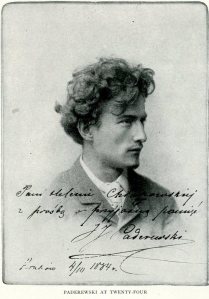
Elżbieta Bilicka (Yamaha) Poland Chopin Concerto No 1 in E-minor. This young pianist is intensely musical and deserved better from the orchestra and conductor than she received. I suppose rehearsal time was limited. I felt the beginning Allegro maestoso was a most unaccustomed experience of phrasing which lead into a laboured tempo. Pride and élan should rule here. There was little liveliness and the maestoso was that of the clogged arteries of a general. Her beautiful phrasing, tone and touch led to a cantabile and lyrical Larghetto or in the words of Chopin to his friend Tytus ‘Involuntarily, something has entered my head through my eyes and I like to caress it.’ In that same letter written to Tytus in May, Chopin describes the character of the Larghetto: ‘The Adagio for the new concerto is in E major. It is not intended to be powerful, it is more romance-like, calm, melancholic, it should give the impression of a pleasant glance at a place where a thousand fond memories come to mind.’ All this was written under a romantic yearning for Konstancja Gładowska. Needless to say she was more interested in two smart young Russian officers in their splendid uniforms. However this movement too was compromised by the slowish orchestral tempo which contributed to Bilicka’s slight nervousness and disadvantage. There was a slight incident of orchestral/soloist disconnection in the Rondo final movement which probably came from the extraordinary demands on stamina made by the competition. It is a very difficult competition with five highly demanding stages, two of which involved concertos. I felt she had simply become mentally and physically tired during this demanding movement.
Rest Breaks and a Few Social Activities
Th competition is not only about music – there are few other activities like rest breaks. lunch, dinner, planting trees….I will allow a few photographs to speak for me.
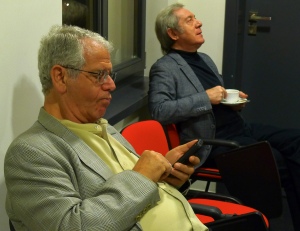
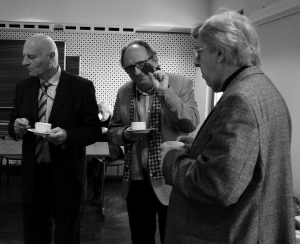

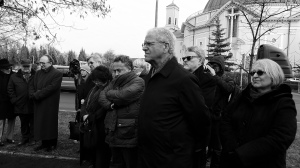
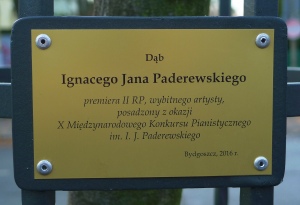

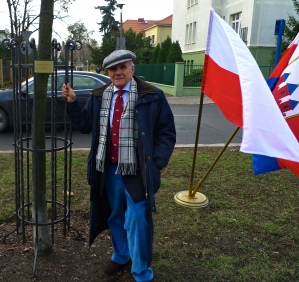
* * * *
You will be interested to know that the competition begins on the officially accepted date of Paderewski’s birthday – November 6th.
And what is the Paderewski connection with Bydgoszcz? In 1918 the 58-year-old composer spent some time on the platform of the Bydgoszcz railway station, walking, stretching his legs and smoking cigarettes. This is the only confirmed episode which unexpectedly turned into a huge Bydgoszcz myth becoming the permanent brand of this city situated on the Brda river. As Paderewski was considered in a similar way to Einstein and Mahatma Gandhi in his day, this myth did not arise from the ether – there was a real basis, however tenuous, for it to grow.
I shall be giving the English Internet commentary and criticism streamed live for the competition. My good friend the eminent music journalist Adam Rozlach will be giving his own assessments in Polish. We have to work out how to do this without boring the pants off everyone. After all playing the piano exquisitely is the great art and often far more important than my personal opinion of these brilliant Wunderkinder.
Here is the internet link to the official competition website:
For the preliminary selection they were expected to perform
- 2 virtuoso etudes (one must have been by Fryderyk Chopin)
- the first or more movements of a classical sonata
- one or two works of the competitor’s choice, in different styles, but not in the classical style.
The 10th International Paderewski Piano Competition in Bydgoszcz, Poland
November 6th – 20th, 2016
List of pianists qualified to the 10th International Paderewski Piano Competition
From 164 applications the Jury originally approved 56 pianists from 19 countries
49 pianists from 16 countries have now confirmed their decision to compete
- Akimoto Kosuke – Japan
- Andreeva Svetlana – Russia
- Bartosik Nora – USA
- Bies Tymoteusz – Poland
- Bilicka Elżbieta – Poland
- Bonev Stefan – Bulgaria
- Candotti Michelle – Italy
- Chen Han – Taiwan
- Chen Yun-Ho – Taiwan
- Davidov Michael – Spain / Israel
- Denisenko Andrey – Russia
- Dorokhova Tatiana – Russia
- Furumi Yasuko – Japan
- Ivanova Dina – Russia
- Kachko Tatiana – Russia
- Kim Eunchan – Korea
- Kim Yedam – Korea
- Kostiuchenko Anatolii – Ukraine
- Kotys Vasyl – Ukraine
- Kuszlik Jakub – Poland
- Lee Hyuk – Korea
- Lee Taek Gi – Korea
- Li Ning Yuen – China/Hong Kong
- Liu Xiaoyu – Canada
- Loatelli Ilaria – Italy
- Morishige Yuka – Japan
- Najafli Narmin – Azerbaijan
- Navarro Priscila – Peru
- Nesterova Anastasiia – Russia
- Noh Yuri – Korea
- Ozaki Misora – Japan
- Panfilov Alexander – Russia
- Park Sejoon – USA
- Pavlovič Aleksandar – Serbia
- Shigeno Tomoka – Japan
- Shmukler Ilya – Russia
- Sporov Mikhail – Russia
- Sudo Rina – Japan
- Sung Jenna – UK
- Świgut Aleksandra – Poland
- Tainaka Takuya – Japan
- Tomaszewski Adam – Poland
- Wierciński Andrzej – Poland
- Yang Xiaohui – China
- Yang Yuanfan – UK
- Yu Mi Hyang – Korea
- Zając Tomasz – Poland
- Zhou Mo – China
- Zhou Tianyu – Canada
What an eclectic selection!
9 participants from Russia, 7 from Poland, 7 from Japan, 6 from South Korea, 3 from China, 2 from Taiwan, 2 from Ukraine, 2 from Canada, 2 from the UK, 2 from Italy, 2 from the USA and one each from Bulgaria, Spain, Azerbaijan, Peru, and Serbia.
Congratulations to all qualified pianists – to be accepted is a remarkable achievement in itself!
The official Book of the Competition in parallel Polish and English text with all the details of the competition, biographical information on the participants as well as their chosen programmes may be accessed using this link:
https://app.box.com/s/80ppuilkci6q7g9sqnl7fyqyus2mdugm
It seems to me that in all international piano competitions, there is often mean-spirited speculation of the relation of qualified pianists to jury members. As a result, this excellent set of rules has been implemented at the Paderewski Competition.
The Paderewski Competition is open to pianists of all nationalities, born between 1984 and 2000.
The following pianists are barred from the Competition:
- pianists who over the last three years (since October 1st, 2013) were regular students of a Juror in any school or academy of music,
- pianists who over the last three years (since October 1st, 2013) took additional private classes with a Juror,
- pianists who are Juror ‘s relatives.
The above restrictions shall not apply to pianists who attended sporadically masterclasses held by a Juror.
Jury of 10th Competition
Piotr Paleczny, Poland – Chairman of the Jury, Artistic Director
Dmitri Alexeev, Russia/Great Britain
Francisco J. Cruz Plaza, Spain
Ewa Pobłocka, Poland
Matti Raekallio, Finland
Soo Jung Shin, S. Korea
Jerzy Sulikowski, Poland
Tamás Ungár, Hungary/USA
Arie Vardi, Israel
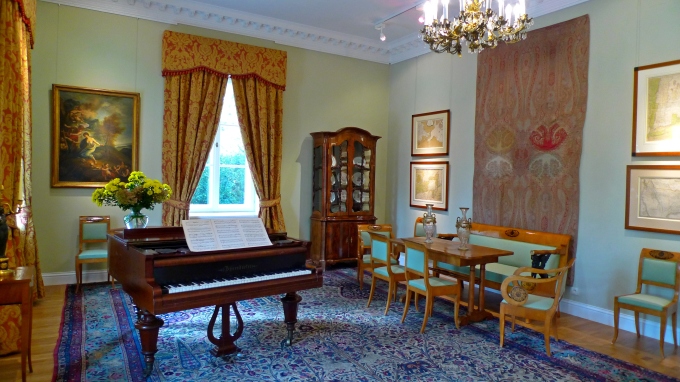
REPERTOIRE OF THE COMPETITION
- The I. J Paderewski Piano Competition offers its participants an opportunity to perform the repertoire of their own choice. Thereby, the Organizers give pianists the chance to present their artistic personality, imagination and individuality.
- NOTICE: Free choice of the repertoire is restricted by one condition only. The repertoire to be performed throughout the Competition should contain works representing at least three different music styles.
- The Jury shall assess the selected repertoire and its rendition taking into account pianists’ ability to construct the program of a recital, understand and render the depth of works representing a variety of musical styles, thereby display musicality and artistic personality.
STAGE I – performance duration 25-30 minutes
Free choice of repertoire
STAGE II – performance duration 45-50 minutes
REPERTOIRE FOR STAGE II
All competitors of the 2nd stage shall perform two or more works by I. J. Paderewski.
All competitors shall select works from group A and B – at least one from each group
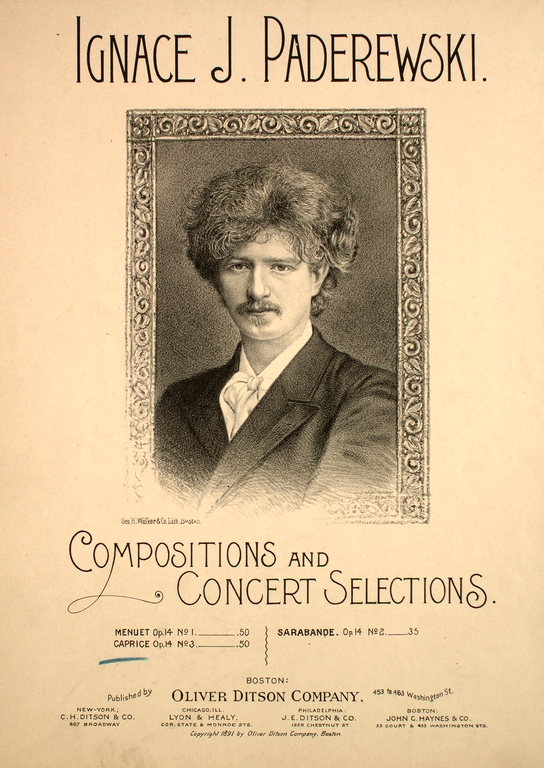
A.
from the series – Polish Dances op. 9:
Mazurka in A major No. 3; Mazurka in B major No. 4
from the series – Album de Mai op.10:
No. 1. Au Soir ; No. 2. Chant d’amour
from the series – Miscellanea op.16:
No. 1. Legend; No. 2 Melody; No. 3 Thėme variė in A major; No. 4 Nocturne;
No. 6 Un moment Musical
B.
from the series – Polish Dances op. 9:
No. 6. Polonaise in H major
from the series – Album de Mai op. 10:
No. 3. Scherzino; No. 5 Caprice Valse
from the series – Humoresques de Concert op. 14:
No. 1. Menuet; No. 2 Sarabande; No. 3 Caprice /genre Scarlatti ; No. 4 Burlesque ; No. 5 Intermezzo polacco; No.6 Cracovienne fantastique
The selection of the remaining works of the 2nd stage repertoire is determined by a pianist.
SEMI-FINAL
A
- Duration 40–45 minutes 1. All the A semi-final participants shall perform a compulsory custom written piece by Zbigniew Bargielski (ca. five minutes). The scores of the composition will be available as soon as the list of Competition participants has been published.
- The selection of remaining pieces performed in A semifinal shall be determined by a pianist.
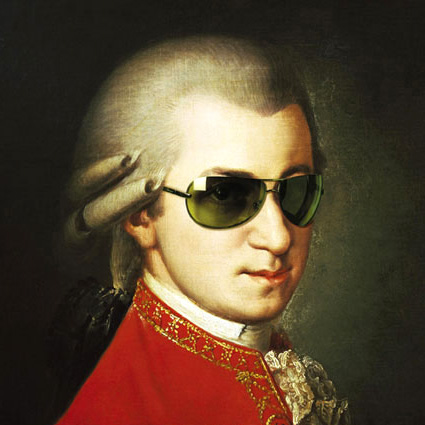
B
MOZART PIANO CONCERTOS
Competitors in the semi-final stage shall perform one of W. A. Mozart piano concertos with the Chamber Orchestra:
No. 15 in B-flat major, K. 450
No. 17 in G major, K. 453
No. 19 in F major, K. 459
No. 20 in D minor, K. 466
No. 21 in C major, K. 467
No. 23 in A major, K. 488
No. 24 in C minor, K. 491
No. 27 in B-flat major, K. 595
FINAL
The competitors of the final stage shall perform with the I. J. Paderewski Pomeranian Philharmonic Orchestra one of the following piano concertos:
Paderewski – Concerto in A minor op. 17 – Polish Fantasy op. 19
Ludwig van Beethoven – Concerto No. 3 in C minor op.37 – Concerto No. 4 in G minor op. 58 – Concerto No. 5 in E flat major op. 7
Chopin – Concerto No. 1 in E minor op. 11 – Concerto No. 2 in F minor op. 21
Schumann – Concerto in A minor op. 54
Liszt – Concerto No. 1 in E-flat major – Concerto No. 2 in A major
Brahms – Concerto No. 1 in D minor op. 15
Tchaikovsky – Concerto No. 1 in B-flat minor op. 23 S.
Rachmaninov – Concerto No. 2 in C minor op.18 – Concerto No. 3 in D minor op. 30 -Rhapsody on a Theme of Paganini op. 43
Prokofiev – Concerto No. 3 in C major op. 26 – Concerto No.2 in G minor, op.16
Szymanowski – Symphonie concertante No.4 op. 60

Piotr Betlej Op 10 N 1 2016 © Galerie Roi Doré
Paderewski is such an underestimated composer of affecting lyrical and poetic piano music which speaks directly to the heart and sensibility rather than burdening the intellect with high seriousness.
Naturally being a great patriot he writes many Polish mazurkas and polonaises but much of his solo piano music reminds me of a superb film score for say an intensely romantic French love affair set in Provence directed by Francois Truffaut. In our imaginations we could be bowling along a poplar lined route secondaire past hills of vineyards with Catherine Deneuve or Stephane Audran in the passenger seat of a Chapron Citroen cabriolet. Her hair is wonderfully awry in the wind as we head towards une belle gentilhommiere and nights of sophisticated sensual bliss, days of cultivated tastes, food and wine. Ah…what we have lost of true civilization and culture in 2016…Paderewski had it all.
The music of Paderewski wears its learning lightly with poetry, charm, elegance and refinement of the highest order. The pieces chosen are an excellent introduction of this neglected repertoire for these young pianists and with luck the pieces might kindle poetry and charm in their playing.
My argument of neglect is validated by the only recording of his complete piano works I know of made by the pianist Karol Radziwonowicz in Warsaw in 1991 in a co-production for the French Le Chant Du Monde label and the Polish label Selene. To my knowledge it has never been reissued. LDC 278 1073/5 distributed by Harmonia Mundi. Used copies are available but at inflated prices.

It is a great pity that the Paderewski Piano Concerto has been so rarely prepared by any participant in this competition. A special prize is even offered for the finest interpretation. Such a lyrical and grand work full of piano pyrotechnics, noble harmonies, dance energy and infectious charm. Audiences would adore it!

For me the finest interpretation of the Paderewski Piano Concerto in A minor Op.17 is by the Polish pianist and Chairman of the Competition Jury Piotr Paleczny with the Sinfonia Varsovia conducted by Jerzy Maksymiuk.
The BeArTon CD is available together with more information on Paderewski as well as the history and gestation of these two works using this link:
http://www.bearton.pl/en/the-best-of-paderewski-en/
You can also hear the work on ‘SoundCloud’ together with the Polish Fantasy for Piano and Orchestra Op.19 here:
- I.J. Paderewski – Polish Fantasy For Piano And Orchestra Op. 19
https://soundcloud.com/piotr-paleczny-2/1-polish-fantasy-for-piano-and-orchestra-op-19
- I.J. Paderewski – Piano Concerto In A Minor Op. 17
- 1st mov. Allegro
- 2nd mov. Romanza. Andante
- 3rd mov. Allegro Molto Vivace
The fine English pianist Johnathan Plowright has recorded the Concerto in A Minor Op. 17, the Polish Fantasia Op. 19, the Sonata Op.21 and the Variations and Fugues Op. 11 & Op. 23 for Hyperion.
Another outstandingly fine account of the Concerto and Fantasia is by Antoni Wit and the National Polish Radio Symphony Orchestra of Katowice with the superb virtuoso Janina Fialkowska as soloist on the Naxos label.

You may like to read this excellent and heartfelt article on Paderewski whilst waiting for the competition to begin
ON THE 75TH ANNIVERSARY OF PADEREWSKI’S DEATH (29 June 1941)
‘Poland is immortal!’
Stanisław Dybowski
So said Ignacy Jan Paderewski on 23 January 1940 at the inaugural meeting of the National Council of the Republic of Poland in Paris, when the situation of the country occupied by two invaders was being pondered. He once said about himself: ‘I am neither lured by power nor attracted to the prestige of being the father of the nation and the more modest position of a useful son of his land would be more than sufficient to me’… and about himself as a pianist: ‘everybody told me – and I was beginning to believe it myself – that I would never be a pianist.’
And yet, his strong belief that Poland is immortal led him right up to the pinnacle of art and politics. He worked in both those areas in order to further his patriotic goals, to which he subordinated everything else!
‘Ignacy Jan Paderewski , said the Primate of Poland in 1986, ‘died in the united States. The funeral ceremonies lasted several days. First, a grand memorial service was held in St. Patrick’s Cathedral in New York. Then, the body was carried to Washington, D.C., and, on 5 July 1941, was laid at Arlington cemetery with military honours. The coffin with the body was laid, but not interred. The funeral was not finished’. It was finished 51 years later, on 5 July 1992, in the presence of the Presidents of Poland and the united States, with the artist’s remains being placed in the crypt of St. John’s cathedral in Warsaw. Thus the will of the Great Pole was implemented, which was to be laid to rest in free Poland, for which he had fought as a politician and a statesman and the cause of which he had championed through his concerts, carrying the name of Frederic Chopin high on his banner.
In his excellent book on Paderewski Adam Zamoyski wrote the following beautiful words:
‘The name of Paderewski was on the lips of many generations. For people who knew nothing about music he was the embodiment of a pianist; for those who knew nothing about Poland he was the embodiment of a fiery Pole; finally, to those who did not have the faintest idea about his political career he looked like Moses – the leader of his people’.
Paderewski made a career – as was often written and said – on a cosmic scale. There has been no human being, before or after him, who enjoyed such a degree of popularity. Even Franz Liszt’s great career, limited to the European continent, could not equal the extent of influence exerted by Paderewski’s name. ‘It was sometimes enough, as poet Jan Lechoń wrote:
‘For Paderewski to appear on stage with his distant look, lion-like hair, a legendary white tie and a modest, almost humble demeanour, more reminiscent of some village bard than a great virtuoso, to make the public stand up and worship in him art itself, all that is unselfish, noble and generous in life and that everyone associated with Paderewski. Paderewski’s star rose in those sad times when Poland was absent from the map of Europe – he was a son of an unhappy country, with no proud embassies or wealthy patrons standing behind him and supporting his art.
However, Paderewski felt Chopin’s soul in his own soul; eager to listen to the voices in his heart, he found in them echoes of a thousand years of our beautiful and magnanimous history; […] listening to those mysterious voices, he felt that he was rich and strong. From the very first time he appeared on the art horizon he behaved like a king; having never asked anyone for anything he always wished to be generous to everyone and all his life was the fulfillment of that wish. […]No one represented true Poland in the eyes of the world better than Paderewski’.
He was formed as an artist at the Warsaw Institute of Music thanks to, among others, Professor Juliusz Janotha (1819–1883), an outstanding pianist and teacher. Professor Władysław Żeleński (1837–1921)gave the following correct assessment of the student’s personality:
‘A young eagle, of a noble breed, proud, courageous, ambitious, a bit aggressive and self-willed but, most of all, independent […]. He had an innate sense of what is right, rebelling against the existing state of affairs if he considered it wrong.’
The great Polish pianist and pedagogue Theodor Leschetizky (1830–1915), Paderewski’s last professor in Vienna, said the following about his pupil for the Tygodnik Ilustrowany weekly in 1899:
‘Paderewski… Paderewski…, repeated Leschetizky several times, as if caressing himself with that word. ‘My pride and honour … He will be a brilliant artist until the end of his days, because he has the character, because he did not and would not think of any goals other than his work … He studied under my guidance for four years, two of which were devoted by him solely to five-finger exercises, until he finally achieved what we call technique … Nowadays he may not be playing for months and will still not lose his skill; his fingers will play by themselves … This is how my system works – to make finger muscles independent from elbow and forearm muscles. It is then that you achieve total freedom … And the style? After the technique we worked on developing the style […], on reconciling the individuality of the virtuoso with the intentions of the composer. The artist’s individuality is a small nucleus contained within a large number of sheaths. The teacher may change the latter, but the nucleus should remain untouched. […] Paderewski is a model that demonstrates exactly how a teacher should instruct his pupil to ensure that everything that his heart may feel and his head may think gets to his fingers through tiny nerve and muscle threads.’
Paderewski achieved everything with hard work, setting high standards for himself expectations and, then, pursuing them mercilessly; he was also always an adamant guardian of the values that he believed in. This manifested itself in him as a virtuoso pianist, a Pole – fighting for his land’s independence, a composer and a teacher. Those traits of his character were noticed by everyone and it was them that drew people to him.
As a Bonner Zeitung critic wrote:
‘Paderewski has become one with the piano just like Chopin did before him. For him the piano is everything – the eye, the ear, the heart and the mouth; the world sings to him in piano tones, he lives the piano and uses it to interact with the world’
while a Kurier Warszawski reporter wrote:
‘For a whole hour the public was flocking to Paderewski’s third concert. In the vestibule downstairs the crowd was filling the staircase and the antechamber on the first floor was so packed with people that any movement towards the grand hall was hardly possible. It did not matter to anyone that other people were treading on his or her feet; even the ladies were not offended if anyone stepped on their train or got caught in their laces. Never mind the train or the laces – we are going to hear Paderewski!’
Edward Risler (1873–1929), a famous pianist and professor at the Consevatoire de Paris, described him briefly as ‘A poet of the piano, a moving performer, a dazzling wizard with a noble heart, great in war and peace. Another piano master, Alfred Cortot (1877–1962), wrote the following in his letter to Paderewski:
‘Is it not to the marvellous charm of Chopin’s work that Poland owes its spiritual survival in human memory in the times of painful slavery? And is it not the inspired performer of his works that has been tasked with the mission of ensuring that his enslaved and martyred land becomes an independent state again? How wonderful and steeped in legend is the epic of a country that owes its liberation more to the lyre than to the sword! All of us who love and admire you are very happy to be able to honour you as a double hero – a hero of Art and of his Motherland!’
Paderewski was a virtuoso, but not in the colloquial, modern meaning of this word, i.e. a musician playing fast and loudly, but rather in the sense that it really expresses. The Latin ‘virtus’ means virtue, manhood, courage, strength and bravery, but also constancy. Those features were characteristic of him in all his activities. In this respect he was close to Chopin, with whom he shared similar views on art, the same love for music and the piano and the same strong uncompromising love for his Motherland!
Paderewski understood – better most people in the past and nowadays – these well-known truths when he said that ‘no country may be happy unless it is free and no country may be free unless it is strong’ and that ‘the cause of the nation is not an undertaking that one should abandon if it yields losses instead of profits. It is a continuous and regular effort, unwavering perseverance and uninterrupted devotion from generation to generation. It can never stop and no penny should ever be spared on it.
In his portrait dedicated to Paderewski the great French composer Charles Gounod wrote only three, but very significant, words: ‘To my dear, great and noble Paderewski’.
On the 75th anniversary of the death of the Great Pole his compatriots will honour him with concerts and the 10th Ignacy Jan Paderewski International Piano Competition to be held on 6–20 November in Bydgoszcz.

Copies of this discerning biography of Paderewski by the masterful author Adam Zamoyski are available on this link




